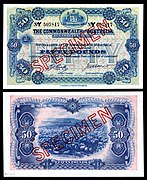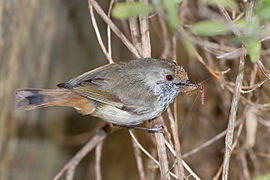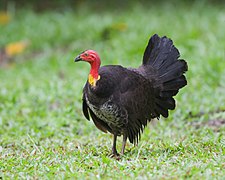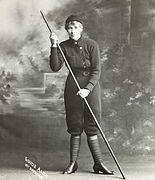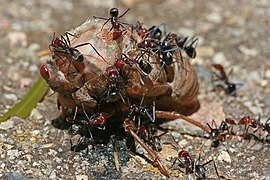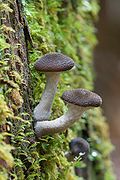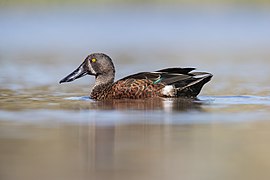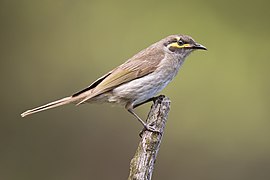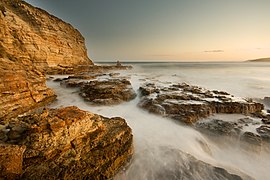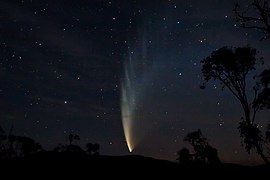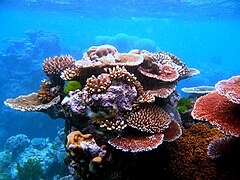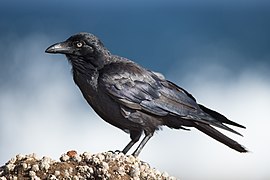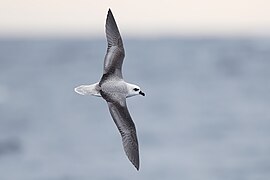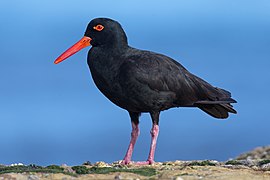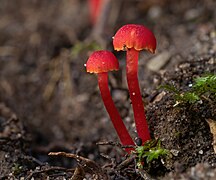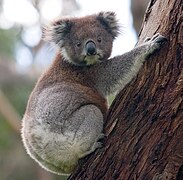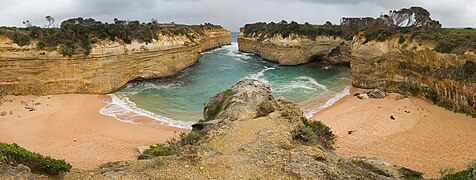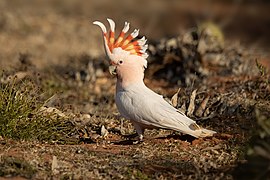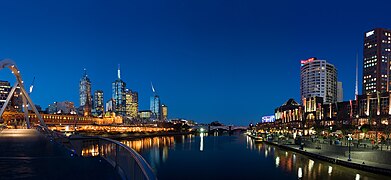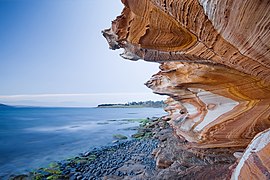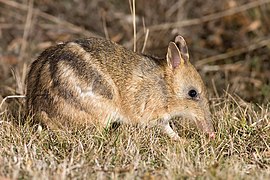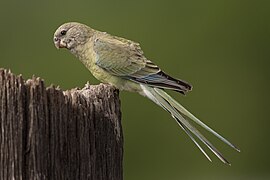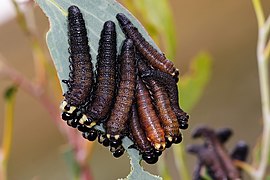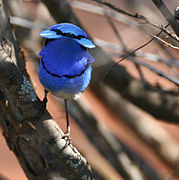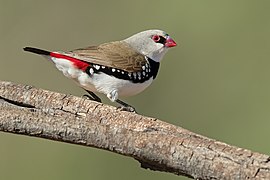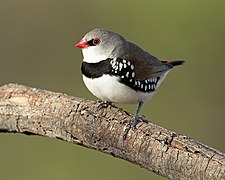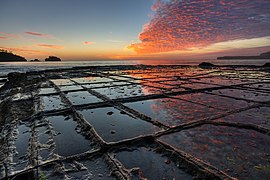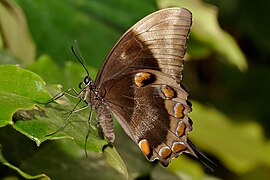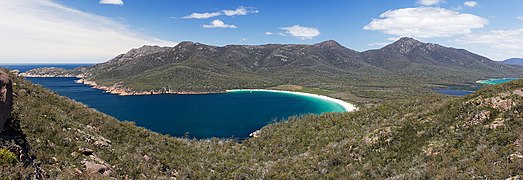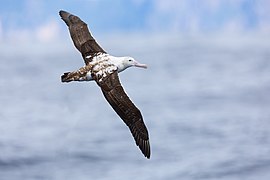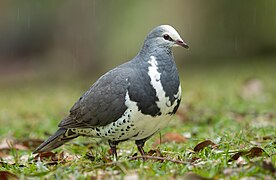| Showcase | Content | Interesting facts | Contributing |
Contents
Featured content - (scrolling list)

Featured content represents the best of what Wikipedia has to offer. These are the articles, pictures, and other contributions that showcase the polished result of the collaborative efforts that drive Wikipedia. All "featured" content undergoes a thorough review process to ensure that it meets the highest standards and can serve as an example of our end goals. A "featured article" or "list" is indicated by the symbol (![]() ) in the top right corner of a page. "Good articles" are those that are considered to be of very high quality, having undergone a similar review process to meet the good article criteria, but have not yet achieved featured article standards. The symbol (
) in the top right corner of a page. "Good articles" are those that are considered to be of very high quality, having undergone a similar review process to meet the good article criteria, but have not yet achieved featured article standards. The symbol (![]() ) in the top right corner of a page indicates "good article" status.
) in the top right corner of a page indicates "good article" status.
As of 7 November 2024, there are 594 featured and 885 good articles within WikiProject Australia's scope.
Featured articles
 1975 Australian constitutional crisis
1975 Australian constitutional crisis Acacia pycnantha
Acacia pycnantha Cyclone Ada
Cyclone Ada Adelaide leak
Adelaide leak Adenanthos cuneatus
Adenanthos cuneatus Adenanthos obovatus
Adenanthos obovatus Admiralty Islands campaign
Admiralty Islands campaign Air Board (Australia)
Air Board (Australia) Air-tractor sledge
Air-tractor sledge Airport Central railway station
Airport Central railway station Aleeta
Aleeta Gubby Allen
Gubby Allen Allied logistics in the Kokoda Track campaign
Allied logistics in the Kokoda Track campaign Alloxylon flammeum
Alloxylon flammeum Alloxylon pinnatum
Alloxylon pinnatum Cyclone Althea
Cyclone Althea William Anderson (RAAF officer)
William Anderson (RAAF officer) Battle of Arawe
Battle of Arawe Armillaria luteobubalina
Armillaria luteobubalina Battle of Arras (1917)
Battle of Arras (1917) Wilfred Arthur
Wilfred Arthur Australasian Antarctic Expedition
Australasian Antarctic Expedition Australasian gannet
Australasian gannet HMAS Australia (1911)
HMAS Australia (1911) Australia at the Winter Olympics
Australia at the Winter Olympics Australia
Australia Australian Air Corps
Australian Air Corps Australian Competition and Consumer Commission v Baxter Healthcare Pty Ltd
Australian Competition and Consumer Commission v Baxter Healthcare Pty Ltd Australian Defence Force
Australian Defence Force Australian boobook
Australian boobook Australian contribution to the Battle of Normandy
Australian contribution to the Battle of Normandy Australian green tree frog
Australian green tree frog Australian magpie
Australian magpie Australian raven
Australian raven Avenue Range Station massacre
Avenue Range Station massacre Axis naval activity in Australian waters
Axis naval activity in Australian waters Peter Badcoe
Peter Badcoe Thomas Baker (aviator)
Thomas Baker (aviator) John Balmer
John Balmer Eric Bana
Eric Bana Bronwyn Bancroft
Bronwyn Bancroft Banded stilt
Banded stilt Banded sugar ant
Banded sugar ant Banksia cuneata
Banksia cuneata Banksia integrifolia
Banksia integrifolia Banksia menziesii
Banksia menziesii Banksia paludosa
Banksia paludosa Banksia sessilis
Banksia sessilis Banksia aculeata
Banksia aculeata Banksia aemula
Banksia aemula Banksia aquilonia
Banksia aquilonia Banksia attenuata
Banksia attenuata Banksia blechnifolia
Banksia blechnifolia Banksia brownii
Banksia brownii Banksia caleyi
Banksia caleyi Banksia canei
Banksia canei Banksia coccinea
Banksia coccinea Banksia dentata
Banksia dentata Banksia epica
Banksia epica Banksia ericifolia
Banksia ericifolia Banksia grossa
Banksia grossa Banksia ilicifolia
Banksia ilicifolia Banksia lemanniana
Banksia lemanniana Banksia marginata
Banksia marginata Banksia oblongifolia
Banksia oblongifolia Banksia petiolaris
Banksia petiolaris Banksia prionotes
Banksia prionotes Banksia scabrella
Banksia scabrella Banksia sceptrum
Banksia sceptrum Banksia serrata
Banksia serrata Banksia speciosa
Banksia speciosa Banksia sphaerocarpa
Banksia sphaerocarpa Banksia spinulosa
Banksia spinulosa Banksia telmatiaea
Banksia telmatiaea Banksia verticillata
Banksia verticillata Banksia violacea
Banksia violacea Battle of Bardia
Battle of Bardia Barn swallow
Barn swallow Sid Barnes
Sid Barnes Sid Barnes with the Australian cricket team in England in 1948
Sid Barnes with the Australian cricket team in England in 1948 Nicky Barr
Nicky Barr Battle of the Eastern Solomons
Battle of the Eastern Solomons Battle of Tassafaronga
Battle of Tassafaronga Otto Becher
Otto Becher Mary Bell (aviator)
Mary Bell (aviator) Jean Bellette
Jean Bellette Frank Berryman
Frank Berryman Battle of the Bismarck Sea
Battle of the Bismarck Sea Black Friday (1945)
Black Friday (1945) Black-breasted buttonquail
Black-breasted buttonquail Black currawong
Black currawong Black honeyeater
Black honeyeater Black-shouldered kite
Black-shouldered kite Arthur Blackburn
Arthur Blackburn Blackrock (film)
Blackrock (film) Frank Bladin
Frank Bladin Thomas Blamey
Thomas Blamey Blue-faced honeyeater
Blue-faced honeyeater Bluey (2018 TV series)
Bluey (2018 TV series) Bodyline
Bodyline Boeing C-17 Globemaster III in Australian service
Boeing C-17 Globemaster III in Australian service Boeing CH-47 Chinook in Australian service
Boeing CH-47 Chinook in Australian service Brian Booth
Brian Booth William Bostock
William Bostock Brabham BT19
Brabham BT19 Brachychiton rupestris
Brachychiton rupestris Don Bradman
Don Bradman Lester Brain
Lester Brain Operation Brevity
Operation Brevity William Brill (RAAF officer)
William Brill (RAAF officer) British nuclear tests at Maralinga
British nuclear tests at Maralinga 1940 Brocklesby mid-air collision
1940 Brocklesby mid-air collision Neil Brooks
Neil Brooks Bill Brown (cricketer)
Bill Brown (cricketer) Raymond Brownell
Raymond Brownell Stanley Bruce
Stanley Bruce Henry Burrell (admiral)
Henry Burrell (admiral) Can't Get You Out of My Head
Can't Get You Out of My Head Canberra
Canberra Cane toad
Cane toad Battle of Cape Esperance
Battle of Cape Esperance Neville Cardus
Neville Cardus Carnaby's black cockatoo
Carnaby's black cockatoo Cattle egret
Cattle egret AHS Centaur
AHS Centaur Central Coast Mariners FC
Central Coast Mariners FC Ian Chappell
Ian Chappell The Chaser APEC pranks
The Chaser APEC pranks Harry Chauvel
Harry Chauvel V. Gordon Childe
V. Gordon Childe Clackline Bridge
Clackline Bridge Harry Cobby
Harry Cobby Cockatoo
Cockatoo Adrian Cole (RAAF officer)
Adrian Cole (RAAF officer) Battle of the Coral Sea
Battle of the Coral Sea Ian Craig
Ian Craig Crescent honeyeater
Crescent honeyeater Dick Cresswell
Dick Cresswell Cyclone Orson
Cyclone Orson Daglish railway station
Daglish railway station Roderic Dallas
Roderic Dallas Phillip Davey
Phillip Davey Bill Denny
Bill Denny Tom Derrick
Tom Derrick Death of Ms Dhu
Death of Ms Dhu Diorama (Silverchair album)
Diorama (Silverchair album) Steve Dodd
Steve Dodd Roy Dowling
Roy Dowling Rupert Downes
Rupert Downes Dream Days at the Hotel Existence
Dream Days at the Hotel Existence Peter Drummond (RAF officer)
Peter Drummond (RAF officer) Vance Drummond
Vance Drummond Don Dunstan
Don Dunstan Eastern Area Command (RAAF)
Eastern Area Command (RAAF) Eastern Suburbs & Illawarra Line
Eastern Suburbs & Illawarra Line Eastern brown snake
Eastern brown snake Tom Eastick
Tom Eastick Brian Eaton
Brian Eaton Charles Eaton (RAAF officer)
Charles Eaton (RAAF officer) Edward VII
Edward VII Edward VIII
Edward VIII Elizabeth II
Elizabeth II Emu
Emu HMS Endeavour
HMS Endeavour Epacris impressa
Epacris impressa David Evans (RAAF officer)
David Evans (RAAF officer) Peter Evans (swimmer)
Peter Evans (swimmer) Neil Hamilton Fairley
Neil Hamilton Fairley Far Eastern Party
Far Eastern Party Ficus macrophylla
Ficus macrophylla Ficus obliqua
Ficus obliqua Ficus rubiginosa
Ficus rubiginosa Fifth Test, 1948 Ashes series
Fifth Test, 1948 Ashes series First Battle of Dernancourt
First Battle of Dernancourt First Test, 1948 Ashes series
First Test, 1948 Ashes series Flame robin
Flame robin Howard Florey
Howard Florey Forest raven
Forest raven Forrest Highway
Forrest Highway Fourth Test, 1948 Ashes series
Fourth Test, 1948 Ashes series Fremantle Prison
Fremantle Prison Frilled lizard
Frilled lizard Florence Fuller
Florence Fuller Convoy GP55
Convoy GP55 Robert Garran
Robert Garran Ragnar Garrett
Ragnar Garrett Ben Gascoigne
Ben Gascoigne George V
George V George VI
George VI Bobby Gibbes
Bobby Gibbes Adam Gilchrist
Adam Gilchrist Stanley Goble
Stanley Goble Goblin shark
Goblin shark Battle of Goodenough Island
Battle of Goodenough Island George Gosse
George Gosse Percy Grainger
Percy Grainger Great Eastern Highway
Great Eastern Highway Greater crested tern
Greater crested tern German invasion of Greece
German invasion of Greece Charles Green (Australian soldier)
Charles Green (Australian soldier) Green rosella
Green rosella Grevillea juniperina
Grevillea juniperina Grey currawong
Grey currawong Guadalcanal campaign
Guadalcanal campaign Half sovereign
Half sovereign Valston Hancock
Valston Hancock Colin Hannah
Colin Hannah Donald Hardman
Donald Hardman Eric Harrison (RAAF officer)
Eric Harrison (RAAF officer) Lindsay Hassett with the Australian cricket team in England in 1948
Lindsay Hassett with the Australian cricket team in England in 1948 Frank Headlam
Frank Headlam Charles Heaphy
Charles Heaphy William Hely
William Hely Battle of Heraklion
Battle of Heraklion Edmund Herring
Edmund Herring Joe Hewitt (RAAF officer)
Joe Hewitt (RAAF officer) Hi-5 (Australian group)
Hi-5 (Australian group) Clem Hill
Clem Hill History of the Australian Capital Territory
History of the Australian Capital Territory Les Holden
Les Holden Cedric Howell
Cedric Howell Paterson Clarence Hughes
Paterson Clarence Hughes I Don't Remember
I Don't Remember Roy Inwood
Roy Inwood Isopogon anemonifolius
Isopogon anemonifolius Isopogon anethifolius
Isopogon anethifolius Archie Jackson
Archie Jackson John Francis Jackson
John Francis Jackson St James' Church, Sydney
St James' Church, Sydney Douglas Jardine
Douglas Jardine Jaws (film)
Jaws (film) Peter Jeffrey (RAAF officer)
Peter Jeffrey (RAAF officer) Frank Jenner
Frank Jenner Jørgen Jensen (soldier)
Jørgen Jensen (soldier) John the bookmaker controversy
John the bookmaker controversy Ian Johnson (cricketer)
Ian Johnson (cricketer) Keith Johnson (cricket administrator)
Keith Johnson (cricket administrator) George Jones (RAAF officer)
George Jones (RAAF officer) Cyclone Joy
Cyclone Joy Battle of Kaiapit
Battle of Kaiapit Mark Kerry
Mark Kerry Bill Kibby
Bill Kibby Elwyn Roy King
Elwyn Roy King King Island emu
King Island emu King brown snake
King brown snake Bruce Kingsbury
Bruce Kingsbury Koala
Koala Kwinana Freeway
Kwinana Freeway Battle of Labuan
Battle of Labuan Lake Burley Griffin
Lake Burley Griffin Lambertia formosa
Lambertia formosa Harold Larwood
Harold Larwood John Leak
John Leak Raymond Leane
Raymond Leane Faith Leech
Faith Leech Murder of Leigh Leigh
Murder of Leigh Leigh John Lerew
John Lerew Letter-winged kite
Letter-winged kite Ray Lindwall with the Australian cricket team in England in 1948
Ray Lindwall with the Australian cricket team in England in 1948 Lockheed C-130 Hercules in Australian service
Lockheed C-130 Hercules in Australian service Sam Loxton
Sam Loxton Sam Loxton with the Australian cricket team in England in 1948
Sam Loxton with the Australian cricket team in England in 1948 M113 armoured personnel carriers in Australian service
M113 armoured personnel carriers in Australian service James Whiteside McCay
James Whiteside McCay Douglas MacArthur
Douglas MacArthur Charlie Macartney
Charlie Macartney Iven Mackay
Iven Mackay Bill Madden (soldier)
Bill Madden (soldier) Garnet Malley
Garnet Malley Jack Marsh
Jack Marsh Masked booby
Masked booby Lionel Matthews
Lionel Matthews SS Mauna Loa
SS Mauna Loa Bill McCann
Bill McCann John McCauley
John McCauley McDonnell Douglas A-4G Skyhawk
McDonnell Douglas A-4G Skyhawk McDonnell Douglas F-4 Phantom II in Australian service
McDonnell Douglas F-4 Phantom II in Australian service McDonnell Douglas F/A-18 Hornet in Australian service
McDonnell Douglas F/A-18 Hornet in Australian service Frank McNamara (RAAF officer)
Frank McNamara (RAAF officer) Ian Dougald McLachlan
Ian Dougald McLachlan Alan McNicoll
Alan McNicoll Ian Meckiff
Ian Meckiff HMAS Melbourne (R21)
HMAS Melbourne (R21) Danie Mellor
Danie Mellor Battle of Milne Bay
Battle of Milne Bay Kylie Minogue
Kylie Minogue Sandra Morgan
Sandra Morgan Battle of Morotai
Battle of Morotai Morotai Mutiny
Morotai Mutiny Arthur Morris
Arthur Morris Muckaty Station
Muckaty Station Alister Murdoch
Alister Murdoch Harry Murray
Harry Murray My Happiness (Powderfinger song)
My Happiness (Powderfinger song) Landing at Nadzab
Landing at Nadzab HMS Nairana (1917)
HMS Nairana (1917) Daisy Jugadai Napaltjarri
Daisy Jugadai Napaltjarri Wintjiya Napaltjarri
Wintjiya Napaltjarri Makinti Napanangka
Makinti Napanangka James Newland
James Newland Bill Newton
Bill Newton Ngo Dinh Diem presidential visit to Australia
Ngo Dinh Diem presidential visit to Australia Robert Nimmo
Robert Nimmo No. 1 Aircraft Depot RAAF
No. 1 Aircraft Depot RAAF No. 1 Flying Training School RAAF
No. 1 Flying Training School RAAF No. 1 Squadron RAAF
No. 1 Squadron RAAF No. 1 Wing RAAF
No. 1 Wing RAAF No. 2 Operational Conversion Unit RAAF
No. 2 Operational Conversion Unit RAAF No. 33 Squadron RAAF
No. 33 Squadron RAAF No. 34 Squadron RAAF
No. 34 Squadron RAAF No. 36 Squadron RAAF
No. 36 Squadron RAAF No. 37 Squadron RAAF
No. 37 Squadron RAAF No. 38 Squadron RAAF
No. 38 Squadron RAAF No. 77 Squadron RAAF
No. 77 Squadron RAAF No. 79 Squadron RAAF
No. 79 Squadron RAAF No. 90 Wing RAAF
No. 90 Wing RAAF No. 91 Wing RAAF
No. 91 Wing RAAF No. 450 Squadron RAAF
No. 450 Squadron RAAF Noisy miner
Noisy miner North-Eastern Area Command
North-Eastern Area Command North Island (Houtman Abrolhos)
North Island (Houtman Abrolhos) North-Western Area Command
North-Western Area Command Northern rosella
Northern rosella Nothomyrmecia
Nothomyrmecia O-Bahn Busway
O-Bahn Busway Ian O'Brien
Ian O'Brien Odyssey Number Five
Odyssey Number Five Kevin O'Halloran
Kevin O'Halloran Mark Oliphant
Mark Oliphant Bronwyn Oliver
Bronwyn Oliver Omphalotus nidiformis
Omphalotus nidiformis Operation Hurricane
Operation Hurricane Operation Pamphlet
Operation Pamphlet Bill O'Reilly (cricketer)
Bill O'Reilly (cricketer) Edward Oxford
Edward Oxford Pacific blue-eye
Pacific blue-eye Daisy Pearce
Daisy Pearce Walter Peeler
Walter Peeler Jerry Pentland
Jerry Pentland Persoonia lanceolata
Persoonia lanceolata Persoonia levis
Persoonia levis Persoonia linearis
Persoonia linearis Persoonia terminalis
Persoonia terminalis Henry Petre
Henry Petre Roy Phillipps
Roy Phillipps Erin Phillips
Erin Phillips Pied butcherbird
Pied butcherbird Pied currawong
Pied currawong Platypus
Platypus Thomas Playford IV
Thomas Playford IV Reg Pollard (general)
Reg Pollard (general) Bill Ponsford
Bill Ponsford Powderfinger
Powderfinger Project Waler
Project Waler Minnie Pwerle
Minnie Pwerle Quietly Confident Quartet
Quietly Confident Quartet RAAF area commands
RAAF area commands Rainbow pitta
Rainbow pitta Peter Raw
Peter Raw Alan Rawlinson
Alan Rawlinson Red-backed fairywren
Red-backed fairywren Red-bellied black snake
Red-bellied black snake Red-capped parrot
Red-capped parrot Red-capped robin
Red-capped robin Red-headed myzomela
Red-headed myzomela Red-tailed black cockatoo
Red-tailed black cockatoo Red-tailed tropicbird
Red-tailed tropicbird Red wattlebird
Red wattlebird Red-winged fairywren
Red-winged fairywren Redback spider
Redback spider Battle of Rennell Island
Battle of Rennell Island Battle of Rethymno
Battle of Rethymno Cyclone Rewa
Cyclone Rewa Rhodesia Information Centre
Rhodesia Information Centre Riverina
Riverina Hilda Rix Nicholas
Hilda Rix Nicholas Ernest Roberts (Australian politician)
Ernest Roberts (Australian politician) Rock parrot
Rock parrot James Rowland (RAAF officer)
James Rowland (RAAF officer) Reg Saunders
Reg Saunders Stanley Savige
Stanley Savige Battle of Savo Island
Battle of Savo Island Scarlet myzomela
Scarlet myzomela Frederick Scherger
Frederick Scherger Second Australian Imperial Force in the United Kingdom
Second Australian Imperial Force in the United Kingdom Second Test, 1948 Ashes series
Second Test, 1948 Ashes series Section 116 of the Constitution of Australia
Section 116 of the Constitution of Australia Norman Selfe
Norman Selfe Short-beaked echidna
Short-beaked echidna Alfred Shout
Alfred Shout Shrine of Remembrance
Shrine of Remembrance Silverchair
Silverchair Singapore strategy
Singapore strategy Battle of Sio
Battle of Sio Addie Viola Smith
Addie Viola Smith Issy Smith
Issy Smith Smooth toadfish
Smooth toadfish Lou Spence
Lou Spence Spinning Around
Spinning Around Splendid fairywren
Splendid fairywren Gordon Steege
Gordon Steege Clare Stevenson
Clare Stevenson Constance Stokes
Constance Stokes Vernon Sturdee
Vernon Sturdee Arthur Sullivan (Australian soldier)
Arthur Sullivan (Australian soldier) Superb fairywren
Superb fairywren Attack on Sydney Harbour
Attack on Sydney Harbour Sydney Riot of 1879
Sydney Riot of 1879 1999 Sydney hailstorm
1999 Sydney hailstorm Don Tallon
Don Tallon Tammar wallaby
Tammar wallaby Tasmanian devil
Tasmanian devil Telopea oreades
Telopea oreades Telopea speciosissima
Telopea speciosissima Telopea truncata
Telopea truncata Battle of the Tenaru
Battle of the Tenaru Third Test, 1948 Ashes series
Third Test, 1948 Ashes series Thopha saccata
Thopha saccata Ian Thorpe
Ian Thorpe Thylacine
Thylacine Mark Tonelli
Mark Tonelli John Tonkin
John Tonkin Ernie Toshack
Ernie Toshack Ernie Toshack with the Australian cricket team in England in 1948
Ernie Toshack with the Australian cricket team in England in 1948 Edgar Towner
Edgar Towner Operation Transom
Operation Transom John Treloar (museum administrator)
John Treloar (museum administrator) Harry Trott
Harry Trott Hugh Trumble
Hugh Trumble Battle of Tulagi and Gavutu–Tanambogo
Battle of Tulagi and Gavutu–Tanambogo Invasion of Tulagi (May 1942)
Invasion of Tulagi (May 1942) Turquoise parrot
Turquoise parrot Van Diemen's Land v Port Phillip, 1851
Van Diemen's Land v Port Phillip, 1851 Variegated fairywren
Variegated fairywren Victoria Cross
Victoria Cross Victoria Cross for Australia
Victoria Cross for Australia Queen Victoria
Queen Victoria Vultee Vengeance in Australian service
Vultee Vengeance in Australian service Ellis Wackett
Ellis Wackett John Lloyd Waddy
John Lloyd Waddy Hector Waller
Hector Waller Allan Walters
Allan Walters Blair Wark
Blair Wark Warlugulong
Warlugulong Warner Bros. Movie World
Warner Bros. Movie World Waterfall Gully, South Australia
Waterfall Gully, South Australia Waterloo Bay massacre
Waterloo Bay massacre Oswald Watt
Oswald Watt Lawrence Weathers
Lawrence Weathers Stanley Price Weir
Stanley Price Weir Henry Wells (general)
Henry Wells (general) Wells and Wellington affair
Wells and Wellington affair Western Area Command (RAAF)
Western Area Command (RAAF) Western Australian emergency of March 1944
Western Australian emergency of March 1944 Western yellow robin
Western yellow robin Australia women's national wheelchair basketball team at the 2012 Summer Paralympics
Australia women's national wheelchair basketball team at the 2012 Summer Paralympics Thomas White (Australian politician)
Thomas White (Australian politician) White-bellied sea eagle
White-bellied sea eagle White swamphen
White swamphen White-winged fairywren
White-winged fairywren Gough Whitlam
Gough Whitlam John Whittle
John Whittle The Wiggles
The Wiggles Maurice Wilder-Neligan
Maurice Wilder-Neligan Richard Williams (RAAF officer)
Richard Williams (RAAF officer) Willie wagtail
Willie wagtail John Wilton (general)
John Wilton (general) Bob Windle
Bob Windle James Park Woods
James Park Woods Military history of Australia during World War II
Military history of Australia during World War II Henry Wrigley
Henry Wrigley Xerochrysum bracteatum
Xerochrysum bracteatum Yarralumla, Australian Capital Territory
Yarralumla, Australian Capital Territory Yellow-faced honeyeater
Yellow-faced honeyeater Yellow-tailed black cockatoo
Yellow-tailed black cockatoo York Park
York Park
Featured lists
 2000 Summer Paralympics medal table
2000 Summer Paralympics medal table 2018 AFL Women's Rising Star
2018 AFL Women's Rising Star List of AFL debuts in 2008
List of AFL debuts in 2008 2016 AFL Rising Star
2016 AFL Rising Star 2017 AFL Rising Star
2017 AFL Rising Star 2017 AFL Women's Rising Star
2017 AFL Women's Rising Star AC/DC discography
AC/DC discography AFL Rising Star
AFL Rising Star Aurealis Award for Best Horror Novel
Aurealis Award for Best Horror Novel Aurealis Award for Best Science Fiction Novel
Aurealis Award for Best Science Fiction Novel Aurealis Award for Best Fantasy Novel
Aurealis Award for Best Fantasy Novel Aurealis Award for Best Young Adult Novel
Aurealis Award for Best Young Adult Novel Australian Crawl discography
Australian Crawl discography Australian Cricket Hall of Fame
Australian Cricket Hall of Fame List of Australian Open men's singles champions
List of Australian Open men's singles champions Barry Sheene Medal
Barry Sheene Medal List of international cricket centuries at Bellerive Oval
List of international cricket centuries at Bellerive Oval Cate Blanchett on screen and stage
Cate Blanchett on screen and stage Blue Heelers season 13
Blue Heelers season 13 List of Bluey episodes
List of Bluey episodes List of international cricket centuries by Greg Chappell
List of international cricket centuries by Greg Chappell Coleman Medal
Coleman Medal Ricki-Lee Coulter discography
Ricki-Lee Coulter discography List of awards and nominations received by Crowded House
List of awards and nominations received by Crowded House Frank Worrell Trophy
Frank Worrell Trophy Delta Goodrem discography
Delta Goodrem discography Gotye discography
Gotye discography Hi-5 discography
Hi-5 discography List of international cricket five-wicket hauls by Mitchell Johnson
List of international cricket five-wicket hauls by Mitchell Johnson Keith 'Bluey' Truscott Trophy
Keith 'Bluey' Truscott Trophy Paul Kelly (Australian musician) discography
Paul Kelly (Australian musician) discography Leader of the Opposition (Australia)
Leader of the Opposition (Australia) List of international cricket five-wicket hauls by Brett Lee
List of international cricket five-wicket hauls by Brett Lee List of international cricket five-wicket hauls by Dennis Lillee
List of international cricket five-wicket hauls by Dennis Lillee List of international cricket five-wicket hauls by Nathan Lyon
List of international cricket five-wicket hauls by Nathan Lyon List of Australia Test cricket records
List of Australia Test cricket records List of Australia Twenty20 International cricketers
List of Australia Twenty20 International cricketers List of Australian George Cross recipients
List of Australian George Cross recipients List of Australian Olympic medallists in swimming
List of Australian Olympic medallists in swimming List of Australian Victoria Cross recipients
List of Australian Victoria Cross recipients List of Brisbane Roar FC players
List of Brisbane Roar FC players List of Central Coast Mariners FC players
List of Central Coast Mariners FC players List of Gold Coast Suns players
List of Gold Coast Suns players List of Major League Baseball players from Australia
List of Major League Baseball players from Australia List of National Rugby League golden point games
List of National Rugby League golden point games List of World Heritage Sites in Australia
List of World Heritage Sites in Australia List of World Series Cricket international centuries
List of World Series Cricket international centuries List of awards and nominations received by Kylie Minogue
List of awards and nominations received by Kylie Minogue List of awards and nominations received by Paul Kelly
List of awards and nominations received by Paul Kelly List of birds of Tasmania
List of birds of Tasmania List of chief commissioners of the Victoria Police
List of chief commissioners of the Victoria Police List of cricketers called for throwing in top-class cricket matches in Australia
List of cricketers called for throwing in top-class cricket matches in Australia List of diprotodonts
List of diprotodonts List of international cricket centuries by Allan Border
List of international cricket centuries by Allan Border List of international cricket centuries by David Boon
List of international cricket centuries by David Boon List of international cricket centuries by David Warner
List of international cricket centuries by David Warner List of international cricket centuries by Don Bradman
List of international cricket centuries by Don Bradman List of international cricket centuries by Matthew Hayden
List of international cricket centuries by Matthew Hayden List of international cricket centuries by Michael Clarke
List of international cricket centuries by Michael Clarke List of international cricket centuries by Ricky Ponting
List of international cricket centuries by Ricky Ponting List of international cricket centuries by Steve Smith
List of international cricket centuries by Steve Smith List of international cricket centuries by Steve Waugh
List of international cricket centuries by Steve Waugh List of international cricket five-wicket hauls by Richie Benaud
List of international cricket five-wicket hauls by Richie Benaud List of international cricket five-wicket hauls by Shane Warne
List of international cricket five-wicket hauls by Shane Warne List of international goals scored by Tim Cahill
List of international goals scored by Tim Cahill List of macropodiformes
List of macropodiformes List of peramelemorphs
List of peramelemorphs List of phalangeriformes
List of phalangeriformes List of premiers of Victoria
List of premiers of Victoria List of prime ministers of Australia
List of prime ministers of Australia Jessica Mauboy discography
Jessica Mauboy discography List of international cricket five-wicket hauls by Glenn McGrath
List of international cricket five-wicket hauls by Glenn McGrath Mike Kable Young Gun Award
Mike Kable Young Gun Award Dannii Minogue discography
Dannii Minogue discography List of songs recorded by Kylie Minogue
List of songs recorded by Kylie Minogue Norm Smith Medal
Norm Smith Medal Paulini discography
Paulini discography Pendulum discography
Pendulum discography Powderfinger discography
Powderfinger discography List of awards and nominations received by Powderfinger
List of awards and nominations received by Powderfinger Guy Sebastian discography
Guy Sebastian discography List of awards and nominations received by Silverchair
List of awards and nominations received by Silverchair Silverchair discography
Silverchair discography Sydney International Piano Competition
Sydney International Piano Competition List of Sydney Metro stations
List of Sydney Metro stations Territorial evolution of Australia
Territorial evolution of Australia The Wiggles discography
The Wiggles discography Trans-Tasman Trophy
Trans-Tasman Trophy Joel Turner discography
Joel Turner discography The Veronicas discography
The Veronicas discography List of international cricket centuries by Mark Waugh
List of international cricket centuries by Mark Waugh Wolfmother discography
Wolfmother discography
Good articles
 1st Armoured Brigade (Australia)
1st Armoured Brigade (Australia) 1st Armoured Regiment (Australia)
1st Armoured Regiment (Australia) 1st Parachute Battalion (Australia)
1st Parachute Battalion (Australia) 2/1st Machine Gun Battalion (Australia)
2/1st Machine Gun Battalion (Australia) 2/2nd Machine Gun Battalion (Australia)
2/2nd Machine Gun Battalion (Australia) 2/3rd Battalion (Australia)
2/3rd Battalion (Australia) 2/3rd Machine Gun Battalion (Australia)
2/3rd Machine Gun Battalion (Australia) 2/4th Machine Gun Battalion (Australia)
2/4th Machine Gun Battalion (Australia) 2/5th Battalion (Australia)
2/5th Battalion (Australia) 2/6th Battalion (Australia)
2/6th Battalion (Australia) 2/7th Battalion (Australia)
2/7th Battalion (Australia) 2/9th Battalion (Australia)
2/9th Battalion (Australia) 2/10th Battalion (Australia)
2/10th Battalion (Australia) 2/14th Battalion (Australia)
2/14th Battalion (Australia) 2/15th Battalion (Australia)
2/15th Battalion (Australia) 2/17th Battalion (Australia)
2/17th Battalion (Australia) 2/18th Battalion (Australia)
2/18th Battalion (Australia) 2/31st Battalion (Australia)
2/31st Battalion (Australia) 2/33rd Battalion (Australia)
2/33rd Battalion (Australia) 2/43rd Battalion (Australia)
2/43rd Battalion (Australia) 2/48th Battalion (Australia)
2/48th Battalion (Australia) 2nd Armoured Brigade (Australia)
2nd Armoured Brigade (Australia) 2nd Battalion (Australia)
2nd Battalion (Australia) 2nd Commando Regiment (Australia)
2nd Commando Regiment (Australia) 3rd Division (Australia)
3rd Division (Australia) 3rd Pioneer Battalion (Australia)
3rd Pioneer Battalion (Australia) 4th Armoured Brigade (Australia)
4th Armoured Brigade (Australia) 6th Battalion (Australia)
6th Battalion (Australia) 6th Division (Australia)
6th Division (Australia) 7th Battalion (Australia)
7th Battalion (Australia) 10th Battalion (Australia)
10th Battalion (Australia) 11th Battalion (Australia)
11th Battalion (Australia) 12th Light Horse Regiment (Australia)
12th Light Horse Regiment (Australia) 14th/32nd Battalion (Australia)
14th/32nd Battalion (Australia) 15th Battalion (Australia)
15th Battalion (Australia) 23rd Battalion (Australia)
23rd Battalion (Australia) 26th Battalion (Australia)
26th Battalion (Australia) 27th Battalion (Australia)
27th Battalion (Australia) 28th Battalion (Australia)
28th Battalion (Australia) 29th Battalion (Australia)
29th Battalion (Australia) 31st/51st Battalion (Australia)
31st/51st Battalion (Australia) 32nd Battalion (Australia)
32nd Battalion (Australia) 39th Battalion (Australia)
39th Battalion (Australia) 49th Battalion (Australia)
49th Battalion (Australia) 61st Battalion (Australia)
61st Battalion (Australia) 108 St Georges Terrace
108 St Georges Terrace 1947 Sydney hailstorm
1947 Sydney hailstorm 1948 Ashes series
1948 Ashes series 1962 Commonwealth Paraplegic Games
1962 Commonwealth Paraplegic Games 1971 World Snooker Championship
1971 World Snooker Championship 1975 World Snooker Championship
1975 World Snooker Championship 1976 World Professional Match-play Championship
1976 World Professional Match-play Championship 1982 Women's Cricket World Cup final
1982 Women's Cricket World Cup final 1988 Women's Cricket World Cup final
1988 Women's Cricket World Cup final 1992 Queensland storms
1992 Queensland storms 1994 FIFA World Cup qualification (CONCACAF–OFC play-off)
1994 FIFA World Cup qualification (CONCACAF–OFC play-off) 1997 Women's Cricket World Cup final
1997 Women's Cricket World Cup final 2001 Australian Grand Prix
2001 Australian Grand Prix 2001 Honda Indy 300
2001 Honda Indy 300 2002–03 Australian region cyclone season
2002–03 Australian region cyclone season 2002 Australian Grand Prix
2002 Australian Grand Prix 2008 Australian Grand Prix
2008 Australian Grand Prix 2008 Port Macquarie-Hastings Council dismissal
2008 Port Macquarie-Hastings Council dismissal 2009 Liberal Party of Australia leadership spill
2009 Liberal Party of Australia leadership spill 2010–11 Australian Baseball League season
2010–11 Australian Baseball League season 2010 Gascoyne River flood
2010 Gascoyne River flood 2010 Claxton Shield
2010 Claxton Shield 2011–12 Australia women's national goalball team
2011–12 Australia women's national goalball team 2012 Armor All Gold Coast 600
2012 Armor All Gold Coast 600 2015 Australian Grand Prix
2015 Australian Grand Prix 2016 Australian Grand Prix
2016 Australian Grand Prix 2018 Batman by-election
2018 Batman by-election 2018 Geelong Football Club season
2018 Geelong Football Club season 2019 AFL Women's Grand Final
2019 AFL Women's Grand Final 2019 Geelong Football Club season
2019 Geelong Football Club season 2019 Geelong Football Club women's season
2019 Geelong Football Club women's season 2019 West Coast Eagles season
2019 West Coast Eagles season 2020 West Coast Eagles season
2020 West Coast Eagles season 2021 AFL Women's Grand Final
2021 AFL Women's Grand Final 2021 West Coast Eagles women's season
2021 West Coast Eagles women's season 2022 AFL Women's season 6 Grand Final
2022 AFL Women's season 6 Grand Final 2022 AFL Women's season 7
2022 AFL Women's season 7 2022 AFL Women's season 7 Grand Final
2022 AFL Women's season 7 Grand Final 2022 Optus data breach
2022 Optus data breach 2023 AFL Grand Final
2023 AFL Grand Final 2023 AFL Women's season
2023 AFL Women's season Abantiades latipennis
Abantiades latipennis Abbotsford Bridge
Abbotsford Bridge Aboriginal Memorial
Aboriginal Memorial Abyss (roller coaster)
Abyss (roller coaster) AC/DC
AC/DC Acanthopagrus butcheri
Acanthopagrus butcheri Aeroplane Jelly
Aeroplane Jelly Air Combat Group RAAF
Air Combat Group RAAF Alamein line
Alamein line Albany Highway
Albany Highway The Albums 2000–2010
The Albums 2000–2010 All the Lovers
All the Lovers Adrian Alston
Adrian Alston Ambassis macleayi
Ambassis macleayi Jessica Anderson (writer)
Jessica Anderson (writer) Angel in Realtime
Angel in Realtime Angels Brought Me Here
Angels Brought Me Here Anstey Hill Recreation Park
Anstey Hill Recreation Park Anti-nuclear movement in Australia
Anti-nuclear movement in Australia Third attack on Anzac Cove
Third attack on Anzac Cove Landing at Anzac Cove
Landing at Anzac Cove Aphrodite (Kylie Minogue album)
Aphrodite (Kylie Minogue album) Aphrodite (song)
Aphrodite (song) Architecture of Fremantle Prison
Architecture of Fremantle Prison Hugo Armstrong
Hugo Armstrong Warwick Armstrong
Warwick Armstrong Aubin Grove railway station
Aubin Grove railway station Augie March
Augie March Australia 31–0 American Samoa
Australia 31–0 American Samoa Australia and the American Civil War
Australia and the American Civil War Australia Day
Australia Day Australia national baseball team
Australia national baseball team Australia at the 1936 Winter Olympics
Australia at the 1936 Winter Olympics Australia at the 2014 Winter Paralympics
Australia at the 2014 Winter Paralympics Australia women's national basketball team
Australia women's national basketball team Australian Academy of Cinema and Television Arts
Australian Academy of Cinema and Television Arts Australian Army during World War I
Australian Army during World War I Australian Army during World War II
Australian Army during World War II Australian Army Reserve
Australian Army Reserve Australian contribution to the Allied Intervention in Russia 1918–1919
Australian contribution to the Allied Intervention in Russia 1918–1919 Australian Crawl
Australian Crawl Australian cricket team in England in 1948
Australian cricket team in England in 1948 Australian football at the 1956 Summer Olympics
Australian football at the 1956 Summer Olympics Australian Marriage Law Postal Survey
Australian Marriage Law Postal Survey 1946 Australian National Airways DC-3 crash
1946 Australian National Airways DC-3 crash 1950 Australian National Airways Douglas DC-4 crash
1950 Australian National Airways Douglas DC-4 crash Australian Voluntary Hospital
Australian Voluntary Hospital Australian contribution to UNTAG
Australian contribution to UNTAG Australian cricket team in England in 1884
Australian cricket team in England in 1884 Australian nationality law
Australian nationality law Australian ringneck
Australian ringneck Australian swellshark
Australian swellshark Australian weasel shark
Australian weasel shark Avondale Agricultural Research Station
Avondale Agricultural Research Station Ayers Rock (band)
Ayers Rock (band) BP Refinery v Tracey
BP Refinery v Tracey The Babadook
The Babadook Back to Basics: Live and Down Under
Back to Basics: Live and Down Under Joany Badenhorst
Joany Badenhorst Ada Baker
Ada Baker Kate Baker
Kate Baker William Baker (colonist)
William Baker (colonist) Bali Nine
Bali Nine Battle of Balikpapan (1945)
Battle of Balikpapan (1945) Angie Ballard
Angie Ballard Bangladeshi cricket team in Australia in 2003
Bangladeshi cricket team in Australia in 2003 Banksia acanthopoda
Banksia acanthopoda Banksia oligantha
Banksia oligantha Banksiamyces
Banksiamyces Bart vs. Australia
Bart vs. Australia Ashleigh Barty
Ashleigh Barty Battle of Cape Gloucester
Battle of Cape Gloucester Henry Baylis
Henry Baylis Bayswater, Western Australia
Bayswater, Western Australia Bayswater railway station, Perth
Bayswater railway station, Perth Bayview Park ferry wharf
Bayview Park ferry wharf Bear Witness
Bear Witness Beaumont House
Beaumont House Bedford, Western Australia
Bedford, Western Australia Battle of Beersheba (1917)
Battle of Beersheba (1917) Behind the Exclusive Brethren
Behind the Exclusive Brethren Belgrave line
Belgrave line Gordon Bennett (general)
Gordon Bennett (general) John Berry (ambassador)
John Berry (ambassador) Best Of... (Sia album)
Best Of... (Sia album) Better than Today
Better than Today Between You & Me (Betty Who song)
Between You & Me (Betty Who song) Frederick Birks
Frederick Birks Battle of Bita Paka
Battle of Bita Paka Black Ice (album)
Black Ice (album) Black Tears
Black Tears Black Widow (Iggy Azalea song)
Black Widow (Iggy Azalea song) Black-headed sugar ant
Black-headed sugar ant Blackrock (play)
Blackrock (play) Cate Blanchett
Cate Blanchett Jennifer Blow
Jennifer Blow Body Language (Kylie Minogue album)
Body Language (Kylie Minogue album) Bogong moth
Bogong moth Marcus Bontempelli
Marcus Bontempelli Susie Bootja Bootja Napaltjarri
Susie Bootja Bootja Napaltjarri Andy Bor
Andy Bor Bounce (Iggy Azalea song)
Bounce (Iggy Azalea song) Bramble Cay melomys
Bramble Cay melomys Breathe (Kylie Minogue song)
Breathe (Kylie Minogue song) Marie Breen
Marie Breen Mark Brennan (Neighbours)
Mark Brennan (Neighbours) Virgil Brennan
Virgil Brennan Mark Bresciano
Mark Bresciano Operation Bribie
Operation Bribie Brolga
Brolga Brooke Street Pier
Brooke Street Pier Victoria Brown (water polo)
Victoria Brown (water polo) Brown honeyeater
Brown honeyeater Ian Browne (cyclist)
Ian Browne (cyclist) Brumby
Brumby Michael Bruxner
Michael Bruxner Charlie Buckton
Charlie Buckton Ruby Buckton
Ruby Buckton Eric Burhop
Eric Burhop Anna Burke
Anna Burke Bush coconut
Bush coconut Butler railway station
Butler railway station Butterfly (Kylie Minogue song)
Butterfly (Kylie Minogue song) BuzzSaw (roller coaster)
BuzzSaw (roller coaster) CFMMEU v Personnel Contracting Pty Ltd
CFMMEU v Personnel Contracting Pty Ltd Luke Cain
Luke Cain Carmella Cammeniti
Carmella Cammeniti Canberra Roller Derby League
Canberra Roller Derby League Naomi Canning
Naomi Canning Cape Moreton Light
Cape Moreton Light Ben Carlin
Ben Carlin Carlisle railway station, Perth
Carlisle railway station, Perth Carrick, Tasmania
Carrick, Tasmania Amanda Carter
Amanda Carter Caulfield Grammar School
Caulfield Grammar School Caulfield railway station
Caulfield railway station The Causeway
The Causeway Central Area Command (RAAF)
Central Area Command (RAAF) Central Flying School RAAF
Central Flying School RAAF Central Park (skyscraper)
Central Park (skyscraper) Challis railway station
Challis railway station Charles III
Charles III Alan Charlesworth
Alan Charlesworth Charlie and the Chocolate Factory (film)
Charlie and the Chocolate Factory (film) Matthew Charlton
Matthew Charlton Cheok Hong Cheong
Cheok Hong Cheong Percy Cherry
Percy Cherry Chocolate (Kylie Minogue song)
Chocolate (Kylie Minogue song) Battle of Chongju (1950)
Battle of Chongju (1950) Christmas Island flying fox
Christmas Island flying fox Christmas imperial pigeon
Christmas imperial pigeon Chudleigh, Tasmania
Chudleigh, Tasmania Cyclone Clare
Cyclone Clare John S. Clark
John S. Clark Daphne Clarke
Daphne Clarke Kayla Clarke
Kayla Clarke Clarkson railway station, Perth
Clarkson railway station, Perth Clean (2022 film)
Clean (2022 film) Climate Change Denial
Climate Change Denial Les Clisby
Les Clisby Operation Coburg
Operation Coburg Operation Cockpit
Operation Cockpit The Cockroaches
The Cockroaches Coffin ray
Coffin ray Jon Coghill
Jon Coghill Ellie Cole
Ellie Cole Toni Collette
Toni Collette Collier Road
Collier Road Herbie Collins
Herbie Collins Concrete bus shelters in Canberra
Concrete bus shelters in Canberra Thomas Cooke (soldier, born 1881)
Thomas Cooke (soldier, born 1881) Priya Cooper
Priya Cooper Miles Copeland (Home and Away)
Miles Copeland (Home and Away) Battle of Coral–Balmoral
Battle of Coral–Balmoral Des Corcoran
Des Corcoran Ernest Corey
Ernest Corey Pearl Corkhill
Pearl Corkhill Al Costello
Al Costello 2020 Coulson Aviation Lockheed C-130 Hercules crash
2020 Coulson Aviation Lockheed C-130 Hercules crash Ricki-Lee Coulter
Ricki-Lee Coulter Council House, Perth
Council House, Perth Cowboy Style
Cowboy Style Cranbourne line
Cranbourne line Lana Crawford
Lana Crawford Creek whaler
Creek whaler Operation Crimp
Operation Crimp Cobi Crispin
Cobi Crispin Jack Critchley
Jack Critchley Charles Crombie
Charles Crombie Death of Patrick Cronin
Death of Patrick Cronin Crossback stingaree
Crossback stingaree Australian Army ship Crusader (AV 2767)
Australian Army ship Crusader (AV 2767) Cullacabardee, Western Australia
Cullacabardee, Western Australia Nigel Cullen
Nigel Cullen Cumberland (rugby league team)
Cumberland (rugby league team) Cyclone Alby
Cyclone Alby Cyclone Alessia
Cyclone Alessia Cyclone Bobby
Cyclone Bobby Cyclone Ilona
Cyclone Ilona Cyclone Kelvin
Cyclone Kelvin Cyclone Peter
Cyclone Peter John D'Orazio
John D'Orazio John Dacey
John Dacey Henry Daglish
Henry Daglish Daglish, Western Australia
Daglish, Western Australia Alan Dale
Alan Dale Bailey Dale
Bailey Dale Joe Darling
Joe Darling Wilbur Dartnell
Wilbur Dartnell Alan Davidson (cricketer, born 1929)
Alan Davidson (cricketer, born 1929) James Davis (escaped convict)
James Davis (escaped convict) Hippolyte De La Rue
Hippolyte De La Rue Emilie de Ravin
Emilie de Ravin Defiant Development
Defiant Development Alessandro Del Piero
Alessandro Del Piero Leanne Del Toso
Leanne Del Toso Félix Delahaye
Félix Delahaye Demobilisation of the Australian military after World War II
Demobilisation of the Australian military after World War II Denisovan
Denisovan Did It Again (Kylie Minogue song)
Did It Again (Kylie Minogue song) Dietrich v The Queen
Dietrich v The Queen Leigh Diffey
Leigh Diffey Diprotodon
Diprotodon Hannah Dodd
Hannah Dodd Double Allergic
Double Allergic Doug Anthony All Stars
Doug Anthony All Stars Dugong
Dugong Battle of Dumpu
Battle of Dumpu Tommy Dunderdale
Tommy Dunderdale Bill Dunn (Pilbara elder)
Bill Dunn (Pilbara elder) Aleksandar Đurić
Aleksandar Đurić Dusky woodswallow
Dusky woodswallow James Francis Dwyer
James Francis Dwyer Eagle Boys
Eagle Boys Russell Ebert
Russell Ebert Lauren Ebsary
Lauren Ebsary Hughie Edwards
Hughie Edwards Peter Edwards (historian)
Peter Edwards (historian) Battle of Elands River (1900)
Battle of Elands River (1900) Electoral district of Perth
Electoral district of Perth Harold Edward Elliott
Harold Edward Elliott Maddison Elliott
Maddison Elliott Embassy of Australia, Washington, D.C.
Embassy of Australia, Washington, D.C. Cyclone Emma (2006)
Cyclone Emma (2006) Battle off Endau
Battle off Endau Enjoy Yourself (Kylie Minogue album)
Enjoy Yourself (Kylie Minogue album) Enlighten Canberra
Enlighten Canberra Entoloma austroprunicolor
Entoloma austroprunicolor Episode 523
Episode 523 Episode 6188
Episode 6188 Episode 8052
Episode 8052 Escape from Woomera
Escape from Woomera Nicole Esdaile
Nicole Esdaile Eucalyptus gomphocephala
Eucalyptus gomphocephala Eucalyptus rhodantha
Eucalyptus rhodantha Eucalyptus wandoo
Eucalyptus wandoo Eureka Flag
Eureka Flag Evermore (band)
Evermore (band) Boyd Exell
Boyd Exell Eyre Highway
Eyre Highway Fabulous Kangaroos
Fabulous Kangaroos Fair Work Ombudsman v Quest South Perth
Fair Work Ombudsman v Quest South Perth Cyclone Fay
Cyclone Fay February 2010 Australian cyberattacks
February 2010 Australian cyberattacks Federated Moulders' (Metals) Union of Australia
Federated Moulders' (Metals) Union of Australia FernGully: The Last Rainforest
FernGully: The Last Rainforest Fever (Kylie Minogue album)
Fever (Kylie Minogue album) Anthony Field
Anthony Field Fighter Squadron RAAF
Fighter Squadron RAAF Finding Nemo
Finding Nemo Fingerprints: The Best of Powderfinger, 1994–2000
Fingerprints: The Best of Powderfinger, 1994–2000 Jack Fingleton
Jack Fingleton Battle of Finschhafen
Battle of Finschhafen First Australian Imperial Force
First Australian Imperial Force Andrew Fisher
Andrew Fisher Edwin Flack
Edwin Flack Edward Ford (physician)
Edward Ford (physician) Fort Glanville Conservation Park
Fort Glanville Conservation Park Russell Foskett
Russell Foskett Nicole Franklin
Nicole Franklin Frankston line
Frankston line Donna Freedman
Donna Freedman Hans Freeman
Hans Freeman Frog cake
Frog cake Ray Funnell
Ray Funnell GBI (German Bold Italic)
GBI (German Bold Italic) GST distribution dispute
GST distribution dispute Jessica Gallagher
Jessica Gallagher Frederick Galleghan
Frederick Galleghan Gallipoli campaign
Gallipoli campaign Battle of Gang Toi
Battle of Gang Toi Gardiner railway station
Gardiner railway station Kylie Gauci
Kylie Gauci Gaussberg
Gaussberg Christian Geiger
Christian Geiger John Gellibrand
John Gellibrand General Dynamics F-111C
General Dynamics F-111C Stanley Gibbs
Stanley Gibbs Aubrey Gibson
Aubrey Gibson Lionel Gilbert
Lionel Gilbert Julia Gillard
Julia Gillard Cyclone Gillian
Cyclone Gillian Glass Spider
Glass Spider Glebe Dirty Reds
Glebe Dirty Reds Glen Iris railway station
Glen Iris railway station Cyclone Glenda
Cyclone Glenda Gnaraloo worm-lizard
Gnaraloo worm-lizard Go Farther in Lightness
Go Farther in Lightness Nick Goiran
Nick Goiran Jessica Gomes
Jessica Gomes SS Gothenburg
SS Gothenburg Albert Gould
Albert Gould Mitchell Gourley
Mitchell Gourley Governor's Body Guard of Light Horse
Governor's Body Guard of Light Horse Grace Beside Me
Grace Beside Me Cyclone Graham
Cyclone Graham Steve Graham
Steve Graham Stuart Clarence Graham
Stuart Clarence Graham Great Northern Highway
Great Northern Highway Great Southern Group
Great Southern Group Green Lantern Coaster
Green Lantern Coaster Green-head ant
Green-head ant Greenwood railway station
Greenwood railway station Jennie Scott Griffiths
Jennie Scott Griffiths Grumman S-2 Tracker in Australian service
Grumman S-2 Tracker in Australian service Cyclone Gwenda
Cyclone Gwenda John Hadley (philosopher)
John Hadley (philosopher) Hadspen, Tasmania
Hadspen, Tasmania Hagley, Tasmania
Hagley, Tasmania Ron Halcombe
Ron Halcombe Ken Hall (Australian footballer)
Ken Hall (Australian footballer) Ron Hamence
Ron Hamence The Harbingers
The Harbingers Tom Harley
Tom Harley Jane Harris (Neighbours)
Jane Harris (Neighbours) Merv Harvey
Merv Harvey Mick Harvey (umpire)
Mick Harvey (umpire) Neil Harvey
Neil Harvey Ray Harvey
Ray Harvey Harvey brothers
Harvey brothers Harvie Krumpet
Harvie Krumpet Lindsay Hassett
Lindsay Hassett Alyssa Healy
Alyssa Healy Bob Heffron
Bob Heffron Cyclone Helen (2007)
Cyclone Helen (2007) Rachel Henderson
Rachel Henderson Percy Henn
Percy Henn Cyclone Herbie
Cyclone Herbie Mary Herring
Mary Herring Hey, Hey, It's Esther Blueburger
Hey, Hey, It's Esther Blueburger Hi-5 (Australian TV series)
Hi-5 (Australian TV series) Missy Higgins
Missy Higgins High Wycombe railway station, Perth
High Wycombe railway station, Perth Katie Hill (basketball)
Katie Hill (basketball) John Hines (Australian soldier)
John Hines (Australian soldier) John Hirst (historian)
John Hirst (historian) History of Fremantle Prison
History of Fremantle Prison Battle of the Hongorai River
Battle of the Hongorai River Hoodoo Gurus
Hoodoo Gurus Hook Me Up (The Veronicas song)
Hook Me Up (The Veronicas song) Tom Hooper
Tom Hooper Meica Horsburgh
Meica Horsburgh Sampson Hosking
Sampson Hosking George Howell (soldier)
George Howell (soldier) Howling Bells
Howling Bells Tim Hughes (soldier)
Tim Hughes (soldier) Lachie Hunter
Lachie Hunter Hunter Mariners
Hunter Mariners Huntingdale railway station
Huntingdale railway station Huon Peninsula campaign
Huon Peninsula campaign I Am Real
I Am Real Icehouse (band)
Icehouse (band) Illawarra Steam Navigation Company
Illawarra Steam Navigation Company Eddie Illingworth
Eddie Illingworth Imperial Gift
Imperial Gift Impossible Is Nothing (Iggy Azalea song)
Impossible Is Nothing (Iggy Azalea song) Impossible Princess
Impossible Princess Impossible Remixes
Impossible Remixes The Inbestigators
The Inbestigators The Inbetweeners 2
The Inbetweeners 2 Infest the Rats' Nest
Infest the Rats' Nest George Ingram
George Ingram HMCS Integrity (1804)
HMCS Integrity (1804) Nestory Irankunda
Nestory Irankunda Iridomyrmex
Iridomyrmex Steve Irwin
Steve Irwin Peter Isaacson
Peter Isaacson Isabelle Eberhardt (film)
Isabelle Eberhardt (film) Battle of Isurava
Battle of Isurava Jack jumper ant
Jack jumper ant Bruce Jackson (audio engineer)
Bruce Jackson (audio engineer) Lauren Jackson
Lauren Jackson Leslie Douglas Jackson
Leslie Douglas Jackson Oliver David Jackson
Oliver David Jackson Janszoon voyage of 1605–1606
Janszoon voyage of 1605–1606 Aden Jefferies
Aden Jefferies Clarence Jeffries
Clarence Jeffries St John the Baptist Church, Reid
St John the Baptist Church, Reid Matthew Charles Johnson
Matthew Charles Johnson Bill Johnston (cricketer)
Bill Johnston (cricketer) Joint Agency Coordination Centre
Joint Agency Coordination Centre Jordanville railway station
Jordanville railway station Justice League: Alien Invasion 3D
Justice League: Alien Invasion 3D Toby Kane
Toby Kane Battle of Kapyong
Battle of Kapyong Kardinya, Western Australia
Kardinya, Western Australia Bridie Kean
Bridie Kean Ged Kearney
Ged Kearney Keating!
Keating! Paul Kelly (Australian musician)
Paul Kelly (Australian musician) Josepha Petrick Kemarre
Josepha Petrick Kemarre Georgina Kenaghan
Georgina Kenaghan Susan Kennedy
Susan Kennedy Wilfrid Kent Hughes
Wilfrid Kent Hughes Sam Kerr
Sam Kerr Kew Asylum
Kew Asylum Battle of Kham Duc
Battle of Kham Duc Nicole Kidman
Nicole Kidman Kids Can Say No!
Kids Can Say No! Alan Kippax
Alan Kippax Patrick Kisnorbo
Patrick Kisnorbo Aubrey Koch
Aubrey Koch Lowe Kong Meng
Lowe Kong Meng Battle of Kranji
Battle of Kranji Battle of Kujin
Battle of Kujin Kylie (album)
Kylie (album) Kylie Minogue (album)
Kylie Minogue (album) Kylie and Garibay (EP)
Kylie and Garibay (EP) Henri L'Estrange
Henri L'Estrange Lady Croissant
Lady Croissant Lakelands railway station
Lakelands railway station Cyclone Lam
Cyclone Lam Landing at Jacquinot Bay
Landing at Jacquinot Bay Landing at Lae
Landing at Lae Rhys Lawson
Rhys Lawson Louis Laybourne Smith
Louis Laybourne Smith Sunny Lee
Sunny Lee Leederville railway station
Leederville railway station Cyclone Leon–Eline
Cyclone Leon–Eline Michelle Leslie
Michelle Leslie Let's Get to It
Let's Get to It Level Crossing Removal Project
Level Crossing Removal Project Light Years (Kylie Minogue album)
Light Years (Kylie Minogue album) Cyclone Lili (2019)
Cyclone Lili (2019) Lilydale line
Lilydale line Horace Lindrum
Horace Lindrum Ray Lindwall
Ray Lindwall Robert A. Little
Robert A. Little Little egret
Little egret Charles Lloyd (Australian general)
Charles Lloyd (Australian general) Battle of Lone Pine
Battle of Lone Pine Battle of Long Khánh
Battle of Long Khánh Battle of Long Tan
Battle of Long Tan Lord Howe Island
Lord Howe Island Lost and Running
Lost and Running Frank Lukis
Frank Lukis Martha MacKenzie
Martha MacKenzie George Mackinolty
George Mackinolty Jack Macrae
Jack Macrae Macrolepiota clelandii
Macrolepiota clelandii Mad Max: Fury Road
Mad Max: Fury Road Robert Madgwick
Robert Madgwick Madonna: Tears of a Clown
Madonna: Tears of a Clown Battle of Magdhaba
Battle of Magdhaba Majura Parkway
Majura Parkway Malaysia Airlines Flight 370 satellite communications
Malaysia Airlines Flight 370 satellite communications Malvern railway station, Melbourne
Malvern railway station, Melbourne Manifesto (2015 film)
Manifesto (2015 film) Ned Manning
Ned Manning Tony Marchant (cyclist)
Tony Marchant (cyclist) Diana Marshall
Diana Marshall Leslie H. Martin
Leslie H. Martin First Battle of Maryang-san
First Battle of Maryang-san Harrie Massey
Harrie Massey Shelley Matheson
Shelley Matheson The Matty Johns Show
The Matty Johns Show Jessica Mauboy
Jessica Mauboy Joseph Maxwell
Joseph Maxwell Marty Mayberry
Marty Mayberry Howard Mayers
Howard Mayers Maylands railway station
Maylands railway station Helen Mayo
Helen Mayo William McAloney
William McAloney Daniel McBreen
Daniel McBreen Stan McCabe
Stan McCabe Gordon McClymont
Gordon McClymont Colin McCool
Colin McCool Alicia McCormack
Alicia McCormack Lewis McGee (soldier)
Lewis McGee (soldier) Ivor McIntyre
Ivor McIntyre Florence Violet McKenzie
Florence Violet McKenzie Tina McKenzie
Tina McKenzie Neville McNamara
Neville McNamara Meander, Tasmania
Meander, Tasmania Meat ant
Meat ant Ricky Megee
Ricky Megee Melbourne Airport
Melbourne Airport Melbourne Storm
Melbourne Storm James Meredith (soccer)
James Meredith (soccer) Amber Merritt
Amber Merritt Battle of Messines (1917)
Battle of Messines (1917) Darren Middleton
Darren Middleton Edward Milford
Edward Milford Military history of Australia
Military history of Australia Edward Millen
Edward Millen Liam Miller
Liam Miller Trent Milton
Trent Milton Richard Minifie
Richard Minifie Mitchell Freeway
Mitchell Freeway Lauren Mitchell
Lauren Mitchell Mixes (Kylie Minogue album)
Mixes (Kylie Minogue album) Monaro Highway
Monaro Highway Mondelez v AMWU
Mondelez v AMWU Cyclone Monica
Cyclone Monica Alan Moore (war artist)
Alan Moore (war artist) Aaron Mooy
Aaron Mooy Frank Morgan (Home and Away)
Frank Morgan (Home and Away) Molly Morgan
Molly Morgan Paddy Morgan
Paddy Morgan Jenny Morris (musician)
Jenny Morris (musician) William Perry French Morris
William Perry French Morris Leslie Morshead
Leslie Morshead Pat Morton
Pat Morton Mount Osmond, South Australia
Mount Osmond, South Australia Mount Waverley railway station
Mount Waverley railway station Murder of Vivianne Ruiz
Murder of Vivianne Ruiz Arthur William Murphy
Arthur William Murphy Murray cod
Murray cod Museum of Contemporary Art Australia
Museum of Contemporary Art Australia Mycena nargan
Mycena nargan Myrmecia (ant)
Myrmecia (ant) Myrmecia inquilina
Myrmecia inquilina Myrmecia nigriceps
Myrmecia nigriceps Myrmecia nigrocincta
Myrmecia nigrocincta Myrmecia regularis
Myrmecia regularis Ngoia Pollard Napaltjarri
Ngoia Pollard Napaltjarri Tjunkiya Napaltjarri
Tjunkiya Napaltjarri Declan Napier
Declan Napier Cyclone Narelle
Cyclone Narelle Narrows Bridge (Perth)
Narrows Bridge (Perth) Laurie Nash
Laurie Nash National War Memorial (South Australia)
National War Memorial (South Australia) German attacks on Nauru
German attacks on Nauru Neighbours 30th Anniversary
Neighbours 30th Anniversary Neighbours
Neighbours John Neild
John Neild New Britain campaign
New Britain campaign New Guinea Air Warning Wireless
New Guinea Air Warning Wireless New Guinea Volunteer Rifles
New Guinea Volunteer Rifles New Zealand and Australian Division
New Zealand and Australian Division John Newham
John Newham Kyle Nix
Kyle Nix No. 1 Basic Flying Training School RAAF
No. 1 Basic Flying Training School RAAF No. 1 Elementary Flying Training School RAAF
No. 1 Elementary Flying Training School RAAF No. 1 Initial Flying Training School RAAF
No. 1 Initial Flying Training School RAAF No. 1 Long Range Flight RAAF
No. 1 Long Range Flight RAAF No. 1 Operational Conversion Unit RAAF
No. 1 Operational Conversion Unit RAAF No. 2 Elementary Flying Training School RAAF
No. 2 Elementary Flying Training School RAAF No. 2 Service Flying Training School RAAF
No. 2 Service Flying Training School RAAF No. 3 Aircraft Depot RAAF
No. 3 Aircraft Depot RAAF No. 3 Elementary Flying Training School RAAF
No. 3 Elementary Flying Training School RAAF No. 4 Elementary Flying Training School RAAF
No. 4 Elementary Flying Training School RAAF No. 4 Operational Training Unit RAAF
No. 4 Operational Training Unit RAAF No. 4 Service Flying Training School RAAF
No. 4 Service Flying Training School RAAF No. 5 Airfield Construction Squadron RAAF
No. 5 Airfield Construction Squadron RAAF No. 5 Elementary Flying Training School RAAF
No. 5 Elementary Flying Training School RAAF No. 5 Operational Training Unit RAAF
No. 5 Operational Training Unit RAAF No. 5 Service Flying Training School RAAF
No. 5 Service Flying Training School RAAF No. 6 Squadron RAAF
No. 6 Squadron RAAF No. 8 Elementary Flying Training School RAAF
No. 8 Elementary Flying Training School RAAF No. 8 Service Flying Training School RAAF
No. 8 Service Flying Training School RAAF No. 11 Elementary Flying Training School RAAF
No. 11 Elementary Flying Training School RAAF No. 20 Squadron RAAF
No. 20 Squadron RAAF No. 30 Transport Unit RAAF
No. 30 Transport Unit RAAF No. 71 Wing RAAF
No. 71 Wing RAAF No. 72 Wing RAAF
No. 72 Wing RAAF No. 73 Wing RAAF
No. 73 Wing RAAF No. 75 Squadron RAAF
No. 75 Squadron RAAF No. 75 Wing RAAF
No. 75 Wing RAAF No. 76 Wing RAAF
No. 76 Wing RAAF No. 77 Wing RAAF
No. 77 Wing RAAF No. 78 Wing RAAF
No. 78 Wing RAAF No. 79 Wing RAAF
No. 79 Wing RAAF No. 80 Wing RAAF
No. 80 Wing RAAF No. 81 Wing RAAF
No. 81 Wing RAAF No. 82 Squadron RAAF
No. 82 Squadron RAAF No. 82 Wing RAAF
No. 82 Wing RAAF No. 84 Wing RAAF
No. 84 Wing RAAF No. 86 Wing RAAF
No. 86 Wing RAAF No. 114 Mobile Control and Reporting Unit RAAF
No. 114 Mobile Control and Reporting Unit RAAF No. 285 Squadron RAAF
No. 285 Squadron RAAF No. 391 Squadron RAAF
No. 391 Squadron RAAF No. 482 Squadron RAAF
No. 482 Squadron RAAF No. 486 Squadron RAAF
No. 486 Squadron RAAF No. 491 Squadron RAAF
No. 491 Squadron RAAF No worries
No worries Nobody Sees
Nobody Sees Cyclone Nora
Cyclone Nora Norah Head Light
Norah Head Light Battle of North Borneo
Battle of North Borneo North West Coastal Highway
North West Coastal Highway John Northcott
John Northcott Northern Area Command (RAAF)
Northern Area Command (RAAF) Northern Command (RAAF)
Northern Command (RAAF) Not All the Beautiful Things
Not All the Beautiful Things Not Quite Hollywood: The Wild, Untold Story of Ozploitation!
Not Quite Hollywood: The Wild, Untold Story of Ozploitation! Clare Nott
Clare Nott Pieter Nuyts
Pieter Nuyts Ray O'Connor
Ray O'Connor Kathleen O'Kelly-Kennedy
Kathleen O'Kelly-Kennedy Oats Street railway station
Oats Street railway station Obernewtyn (novel)
Obernewtyn (novel) Richard Edward O'Connor
Richard Edward O'Connor Old Melbourne Gaol
Old Melbourne Gaol Harold Oliver (Australian footballer)
Harold Oliver (Australian footballer) Cyclone Olivia
Cyclone Olivia On a Clear Night
On a Clear Night On a Night Like This
On a Night Like This Norm O'Neill
Norm O'Neill Operation Mosaic
Operation Mosaic Operation Pig Bristle
Operation Pig Bristle Operation Totem
Operation Totem John O'Reily
John O'Reily HMS Otranto
HMS Otranto Cyclone Owen
Cyclone Owen Battle of Pakchon
Battle of Pakchon Pakenham line
Pakenham line Palace Hotel, Perth
Palace Hotel, Perth Chris Pappas (Neighbours)
Chris Pappas (Neighbours) Parables for Wooden Ears
Parables for Wooden Ears Bridget Parker
Bridget Parker Parliament railway station
Parliament railway station First Battle of Passchendaele
First Battle of Passchendaele Passenger (Powderfinger song)
Passenger (Powderfinger song) Battle of Pearl Ridge
Battle of Pearl Ridge Pell v The Queen
Pell v The Queen Victoria Pendergast
Victoria Pendergast Perfection (Dannii Minogue song)
Perfection (Dannii Minogue song) Melissa Perrine
Melissa Perrine HMAS Perth (D29)
HMAS Perth (D29) Perth Underground railway station
Perth Underground railway station Petition of Right
Petition of Right Arthur Phillip
Arthur Phillip 1916 Pioneer Exhibition Game
1916 Pioneer Exhibition Game Pirates of the Caribbean: Dead Men Tell No Tales
Pirates of the Caribbean: Dead Men Tell No Tales Plain maskray
Plain maskray Point Stephens Light
Point Stephens Light Point Walter
Point Walter Early life of Ricky Ponting
Early life of Ricky Ponting Port Adelaide Football Club
Port Adelaide Football Club Christian Porter
Christian Porter Battle of Porton Plantation
Battle of Porton Plantation Leah Poulton
Leah Poulton Presbyterian Ladies' College, Sydney
Presbyterian Ladies' College, Sydney Primary Colours (Eddy Current Suppression Ring album)
Primary Colours (Eddy Current Suppression Ring album) Prime7
Prime7 Prince of Wales (1786 ship)
Prince of Wales (1786 ship) Prionomyrmecini
Prionomyrmecini Pteropus
Pteropus Edward Pulsford
Edward Pulsford Purple-crowned fairywren
Purple-crowned fairywren Put the Needle on It
Put the Needle on It Put Yourself in My Place (Kylie Minogue song)
Put Yourself in My Place (Kylie Minogue song) Quoll
Quoll R v Thomas
R v Thomas RAAF Transport Flight (Japan)
RAAF Transport Flight (Japan) Iso Rae
Iso Rae Cameron Rahles-Rahbula
Cameron Rahles-Rahbula Glencora Ralph
Glencora Ralph Battle of Ratsua
Battle of Ratsua The Razors Edge (AC/DC album)
The Razors Edge (AC/DC album) Charles Read (RAAF officer)
Charles Read (RAAF officer) Real Groove
Real Groove Rebel Heart Tour (album)
Rebel Heart Tour (album) Red Blooded Woman
Red Blooded Woman Red fox
Red fox Redcliffe railway station
Redcliffe railway station Reticulate whipray
Reticulate whipray Rhee Taekwon-Do
Rhee Taekwon-Do Rhythm of Love (Kylie Minogue album)
Rhythm of Love (Kylie Minogue album) Doug Ring
Doug Ring River Torrens
River Torrens Horace Robertson
Horace Robertson Charlene Robinson
Charlene Robinson Paul Robinson (Neighbours)
Paul Robinson (Neighbours) Cyclone Rosita
Cyclone Rosita Gunther E. Rothenberg
Gunther E. Rothenberg Sydney Rowell
Sydney Rowell Ryan Rowland-Smith
Ryan Rowland-Smith Royal Australian Regiment
Royal Australian Regiment Running Back (Jessica Mauboy song)
Running Back (Jessica Mauboy song) Michael Rush (rower)
Michael Rush (rower) Monique Ryan
Monique Ryan Michelle Rzepecki
Michelle Rzepecki Ron Saggers
Ron Saggers Landing at Saidor
Landing at Saidor St John's, Ashfield
St John's, Ashfield St. John's Orphanage
St. John's Orphanage Cyclone Sam
Cyclone Sam Battle of the Samichon River
Battle of the Samichon River Sand whiting
Sand whiting Sarus crane
Sarus crane Battle of Sattelberg
Battle of Sattelberg Saving Mr. Banks
Saving Mr. Banks Aaron Saxton
Aaron Saxton Sophie Scamps
Sophie Scamps Landing at Scarlet Beach
Landing at Scarlet Beach Charles Scherf
Charles Scherf Seaforth railway station
Seaforth railway station Seaplane Squadron RAAF
Seaplane Squadron RAAF Second Battle of Passchendaele
Second Battle of Passchendaele Selarang Barracks incident
Selarang Barracks incident Ted Serong
Ted Serong Setirostris
Setirostris Dave Shannon
Dave Shannon Shannon (horse)
Shannon (horse) Dave Sharma
Dave Sharma Teddy Sheean
Teddy Sheean Jaz Shelley
Jaz Shelley Sherwood railway station, Perth
Sherwood railway station, Perth Shivers (The Boys Next Door song)
Shivers (The Boys Next Door song) Showdown (Pendulum song)
Showdown (Pendulum song) Showgirl: Homecoming Live
Showgirl: Homecoming Live Sia
Sia Colin Hall Simpson
Colin Hall Simpson Since I Left You
Since I Left You Since I Left You (song)
Since I Left You (song) William Sinclair-Burgess
William Sinclair-Burgess Rosemary Edna Sinclair
Rosemary Edna Sinclair Billy Sing
Billy Sing Sir Thursday
Sir Thursday Skirt (song)
Skirt (song) Battle of Slater's Knoll
Battle of Slater's Knoll Slow (Kylie Minogue song)
Slow (Kylie Minogue song) Ben Small (politician)
Ben Small (politician) Small Mercies
Small Mercies Steve Smith (cricketer)
Steve Smith (cricketer) Snowy Mountains Highway
Snowy Mountains Highway So Under Pressure
So Under Pressure Some Kind of Bliss
Some Kind of Bliss Somebody That I Used to Know
Somebody That I Used to Know Sometime Samurai
Sometime Samurai The Sound of White
The Sound of White South African War Memorial (South Australia)
South African War Memorial (South Australia) South Australian Mounted Rifles
South Australian Mounted Rifles Mernda line
Mernda line Southeast Asia Treaty Organization
Southeast Asia Treaty Organization Southern Area Command (RAAF)
Southern Area Command (RAAF) Mark Soyer
Mark Soyer Sparsely spotted stingaree
Sparsely spotted stingaree Special Air Service Regiment
Special Air Service Regiment Percy Statton
Percy Statton Zali Steggall
Zali Steggall Step Back in Time
Step Back in Time Pamela Stephenson
Pamela Stephenson Sarah Stewart (basketball)
Sarah Stewart (basketball) Mark Stockwell
Mark Stockwell Stony Point line
Stony Point line Percy Storkey
Percy Storkey Storm Coaster
Storm Coaster Striped honeyeater
Striped honeyeater Strobilomyces foveatus
Strobilomyces foveatus Battle of Sungei Koemba
Battle of Sungei Koemba Sunlight (Spacey Jane album)
Sunlight (Spacey Jane album) Sunsets (song)
Sunsets (song) Battle of Suoi Bong Trang
Battle of Suoi Bong Trang Battle of Suoi Chau Pha
Battle of Suoi Chau Pha Surface Fleet Review
Surface Fleet Review Survivor: The Australian Outback
Survivor: The Australian Outback Swimming at the 1980 Summer Olympics – Men's 4 × 100 metre medley relay
Swimming at the 1980 Summer Olympics – Men's 4 × 100 metre medley relay Linda Syddick Napaltjarri
Linda Syddick Napaltjarri HMAS Sydney (D48)
HMAS Sydney (D48) Sydney punchbowls
Sydney punchbowls Tanks in the Australian Army
Tanks in the Australian Army Tasmanian Wilderness World Heritage Area
Tasmanian Wilderness World Heritage Area Tasmanian numbfish
Tasmanian numbfish Taxiride
Taxiride Tyan Taylor
Tyan Taylor Tea & Sympathy (Bernard Fanning album)
Tea & Sympathy (Bernard Fanning album) Cyclone Tessi
Cyclone Tessi These Days: Live in Concert
These Days: Live in Concert The Thin Red Line (1998 film)
The Thin Red Line (1998 film) Thirsty Merc
Thirsty Merc Thornlie line
Thornlie line Tiger quoll
Tiger quoll Tim Watson-Munro
Tim Watson-Munro Time on Earth
Time on Earth Ernest Titterton
Ernest Titterton Turkey Tolson Tjupurrula
Turkey Tolson Tjupurrula Tonkin Highway
Tonkin Highway Touch Me Like That
Touch Me Like That Toyota Aurion (XV40)
Toyota Aurion (XV40) Trams in Adelaide
Trams in Adelaide Transfusion (EP)
Transfusion (EP) Vernon Treatt
Vernon Treatt Trial of Lex Wotton
Trial of Lex Wotton John Triscari
John Triscari Battle of Tsimba Ridge
Battle of Tsimba Ridge Nina Tucker
Nina Tucker Ben Tudhope
Ben Tudhope Tupou VI
Tupou VI Peter Turnbull (RAAF officer)
Peter Turnbull (RAAF officer) Unbroken (Stan Walker song)
Unbroken (Stan Walker song) Underbelly series 1
Underbelly series 1 United Nations Command–Rear
United Nations Command–Rear United States invasion of Afghanistan
United States invasion of Afghanistan Upfield line
Upfield line Teigan Van Roosmalen
Teigan Van Roosmalen Jack Verge
Jack Verge Victoria Park railway station, Perth
Victoria Park railway station, Perth Sarah Vinci
Sarah Vinci Vulture Street (album)
Vulture Street (album) James Walker (Australian politician)
James Walker (Australian politician) Nathan Walker
Nathan Walker William Walker (Australian cricketer)
William Walker (Australian cricketer) Battle of Wareo
Battle of Wareo Warnbro railway station
Warnbro railway station Len Waters
Len Waters Jack Watts (footballer)
Jack Watts (footballer) Naomi Watts
Naomi Watts Reginald Weaver
Reginald Weaver Mark Webber (racing driver)
Mark Webber (racing driver) Flag of Western Australia
Flag of Western Australia Western rosella
Western rosella Where Is the Feeling?
Where Is the Feeling? Where We Land
Where We Land Where the Angels Fall
Where the Angels Fall Jeff White (Australian footballer)
Jeff White (Australian footballer) WhiteWater World
WhiteWater World Whitemore, Tasmania
Whitemore, Tasmania Who Really Cares (Featuring the Sound of Insanity)
Who Really Cares (Featuring the Sound of Insanity) The Wiggles Pty Ltd
The Wiggles Pty Ltd Phillip Wilcher
Phillip Wilcher Wildflower (The Avalanches album)
Wildflower (The Avalanches album) Cliff Williams
Cliff Williams Natasha Williams (Neighbours)
Natasha Williams (Neighbours) Tom Wills
Tom Wills Joe Wilson (Australian footballer)
Joe Wilson (Australian footballer) Gus Winckel
Gus Winckel Colin Windon
Colin Windon Cyclone Winifred
Cyclone Winifred Bill Woodfull
Bill Woodfull Work (Iggy Azalea song)
Work (Iggy Azalea song) Military history of Australia during World War I
Military history of Australia during World War I World War II
World War II The X Factor (Australian TV series) season 3
The X Factor (Australian TV series) season 3 X (Kylie Minogue album)
X (Kylie Minogue album) John Yarra
John Yarra Battle of Yongyu
Battle of Yongyu You (Regard, Troye Sivan and Tate McRae song)
You (Regard, Troye Sivan and Tate McRae song) Young Modern
Young Modern
Featured topics
Good topics
In the News articles
 2009 Australian dust storm
2009 Australian dust storm 2009 southeast Queensland oil spill
2009 southeast Queensland oil spill 2009 southeastern Australia heat wave
2009 southeastern Australia heat wave 2010–2011 Queensland floods
2010–2011 Queensland floods 2010 AFL Grand Final
2010 AFL Grand Final 2010 Australian Labor Party leadership spill
2010 Australian Labor Party leadership spill 2010 Australian federal election
2010 Australian federal election 2011 AFL Grand Final
2011 AFL Grand Final 2012 Melbourne Cup
2012 Melbourne Cup June 2013 Australian Labor Party leadership spill
June 2013 Australian Labor Party leadership spill 2013–14 Ashes series
2013–14 Ashes series 2013 Ashes series
2013 Ashes series 2013 Australian federal election
2013 Australian federal election 2013 Melbourne Cup
2013 Melbourne Cup 2014 Melbourne Cup
2014 Melbourne Cup September 2015 Liberal Party of Australia leadership spill
September 2015 Liberal Party of Australia leadership spill 2015 AFL Grand Final
2015 AFL Grand Final 2015 Ashes series
2015 Ashes series 2015 Melbourne Cup
2015 Melbourne Cup 2016 AFL Grand Final
2016 AFL Grand Final 2016 Australian federal election
2016 Australian federal election 2017–18 Ashes series
2017–18 Ashes series 2018 AFL Grand Final
2018 AFL Grand Final 2018 Liberal Party of Australia leadership spills
2018 Liberal Party of Australia leadership spills 2019–20 Australian bushfire season
2019–20 Australian bushfire season 2019 Australian federal election
2019 Australian federal election 2020 ICC Women's T20 World Cup
2020 ICC Women's T20 World Cup 2021–22 Ashes series
2021–22 Ashes series 2022 AFL Grand Final
2022 AFL Grand Final 2022 Australian federal election
2022 Australian federal election 2023 AFL Grand Final
2023 AFL Grand Final 2023 Ashes series
2023 Ashes series 2023 Australian Indigenous Voice referendum
2023 Australian Indigenous Voice referendum 2023 FIFA Women's World Cup
2023 FIFA Women's World Cup 2023 ICC World Test Championship final
2023 ICC World Test Championship final 2024 AFL Grand Final
2024 AFL Grand Final HMAS AE1
HMAS AE1 AUKUS
AUKUS Mike Agostini
Mike Agostini Ekaterina Alexandrovskaya
Ekaterina Alexandrovskaya Kyle Anderson (darts player)
Kyle Anderson (darts player) Doug Anthony
Doug Anthony Jayo Archer
Jayo Archer Julian Assange
Julian Assange Australia women's national cricket team
Australia women's national cricket team 2008–09 Australian bushfire season
2008–09 Australian bushfire season Australian Grand Prix
Australian Grand Prix 2009 Australian Open
2009 Australian Open 2010 Australian Open
2010 Australian Open 2011 Australian Open
2011 Australian Open 2012 Australian Open
2012 Australian Open 2013 Australian Open
2013 Australian Open 2014 Australian Open
2014 Australian Open 2015 Australian Open
2015 Australian Open 2016 Australian Open
2016 Australian Open 2021 Australian Open
2021 Australian Open 2018 Australian ball-tampering scandal
2018 Australian ball-tampering scandal Australovenator
Australovenator Allen Aylett
Allen Aylett Mike Bailey (weatherman)
Mike Bailey (weatherman) Jesse Baird
Jesse Baird Bali Nine
Bali Nine Ron Barassi
Ron Barassi Jacinda Barclay
Jacinda Barclay Tony Barry
Tony Barry John Bathersby
John Bathersby Richie Benaud
Richie Benaud Max Bingham
Max Bingham Black Saturday bushfires
Black Saturday bushfires Elizabeth Blackburn
Elizabeth Blackburn Bondi Junction stabbings
Bondi Junction stabbings Brian Booth
Brian Booth Jack Brabham
Jack Brabham Lilliane Brady
Lilliane Brady Brereton Report
Brereton Report Bob Brett
Bob Brett John Cain (41st Premier of Victoria)
John Cain (41st Premier of Victoria) Carmen Callil
Carmen Callil Jan Cameron (coach)
Jan Cameron (coach) Arianne Caoili
Arianne Caoili Phil Carlson
Phil Carlson Helena Carr
Helena Carr John Carrick (Australian politician)
John Carrick (Australian politician) Ernie Carroll
Ernie Carroll Ken Catchpole
Ken Catchpole Catholic sexual abuse scandal in Victoria
Catholic sexual abuse scandal in Victoria Death of Azaria Chamberlain
Death of Azaria Chamberlain Michael Chamberlain
Michael Chamberlain Jack Charles
Jack Charles Chris (sheep)
Chris (sheep) 2010 Christmas Island boat disaster
2010 Christmas Island boat disaster Aguil Chut-Deng
Aguil Chut-Deng John Clarke (satirist)
John Clarke (satirist) Ron Clarke
Ron Clarke Inga Clendinnen
Inga Clendinnen John H. Coates
John H. Coates 2018 Commonwealth Games
2018 Commonwealth Games Comprehensive and Progressive Agreement for Trans-Pacific Partnership
Comprehensive and Progressive Agreement for Trans-Pacific Partnership Penny Cook
Penny Cook Kevin Coombs
Kevin Coombs Ashley Cooper (tennis)
Ashley Cooper (tennis) David Cooper (immunologist)
David Cooper (immunologist) John Cornell
John Cornell Simon Crean
Simon Crean Joan Croll
Joan Croll Paul Cronin
Paul Cronin Peter Cundall
Peter Cundall June Dally-Watkins
June Dally-Watkins Killing of Justine Damond
Killing of Justine Damond Jacqueline Dark
Jacqueline Dark Neil Davey
Neil Davey Alan Davidson (cricketer, born 1929)
Alan Davidson (cricketer, born 1929) Destiny Deacon
Destiny Deacon Deepsea Challenger
Deepsea Challenger Denisovan
Denisovan Anne Deveson
Anne Deveson Diamantinasaurus
Diamantinasaurus Diamond Jubilee of Elizabeth II
Diamond Jubilee of Elizabeth II Dick Diamonde
Dick Diamonde Carmen Duncan
Carmen Duncan Simon Dunn
Simon Dunn 2021 eastern Australia floods
2021 eastern Australia floods Peter Eckersley (computer scientist)
Peter Eckersley (computer scientist) Geoffrey Edelsten
Geoffrey Edelsten Elizabeth II
Elizabeth II Ted Evans (public servant)
Ted Evans (public servant) Cecil Exum
Cecil Exum John Fahey (politician)
John Fahey (politician) Polly Farmer
Polly Farmer Taryn Fiebig
Taryn Fiebig 2023 FIFA Women's World Cup final
2023 FIFA Women's World Cup final Tim Fischer
Tim Fischer Diana Fisher
Diana Fisher Danny Frawley
Danny Frawley Graham Freudenberg
Graham Freudenberg Fromelles (Pheasant Wood) Military Cemetery
Fromelles (Pheasant Wood) Military Cemetery Margaret Fulton
Margaret Fulton 2014 G20 Brisbane summit
2014 G20 Brisbane summit Cyclone Gabrielle
Cyclone Gabrielle Reg Gasnier
Reg Gasnier John Gleeson (cricketer)
John Gleeson (cricketer) David Goodall (botanist)
David Goodall (botanist) Mike Gore (physicist)
Mike Gore (physicist) Ainsley Gotto
Ainsley Gotto Bill Granger
Bill Granger Tom Graveney
Tom Graveney Vivean Gray
Vivean Gray Reg Grundy
Reg Grundy Margaret Guilfoyle
Margaret Guilfoyle David Gulpilil
David Gulpilil John Hamblin
John Hamblin Catherine Hamlin
Catherine Hamlin Brian Harradine
Brian Harradine Rolf Harris
Rolf Harris Geoff Harvey
Geoff Harvey Bob Hawke
Bob Hawke Shirley Hazzard
Shirley Hazzard Alyssa Healy
Alyssa Healy Brian Henderson (television presenter)
Brian Henderson (television presenter) Taj El-Din Hilaly
Taj El-Din Hilaly Bones Hillman
Bones Hillman Phillip Hughes
Phillip Hughes Barry Humphries
Barry Humphries 2020 ICC Women's T20 World Cup final
2020 ICC Women's T20 World Cup final 2022 ICC Men's T20 World Cup
2022 ICC Men's T20 World Cup 2012 Indian Ocean migrant boat disaster
2012 Indian Ocean migrant boat disaster Peter Ingham (bishop)
Peter Ingham (bishop) Peter Isaacson
Peter Isaacson Clive James
Clive James Barry Jarman
Barry Jarman Michael Jeffery
Michael Jeffery Dean Jones (cricketer)
Dean Jones (cricketer) Ignatius Jones
Ignatius Jones Siri Kannangara
Siri Kannangara Hugh Keays-Byrne
Hugh Keays-Byrne Noel Kelly (rugby league)
Noel Kelly (rugby league) John Kennedy Sr. (footballer)
John Kennedy Sr. (footballer) Paul B. Kidd
Paul B. Kidd Ian Kiernan
Ian Kiernan Inge King
Inge King Kimberley Kitching
Kimberley Kitching John Konrads
John Konrads Leonie Kramer
Leonie Kramer John Landy
John Landy Ningali Lawford
Ningali Lawford Bill Leak
Bill Leak David Leckie
David Leckie Terry Lewis (police officer)
Terry Lewis (police officer) Lindt Cafe siege
Lindt Cafe siege Alastair Little
Alastair Little Jeanne Little
Jeanne Little Tom Long (actor)
Tom Long (actor) Jarrod Lyle
Jarrod Lyle Charles Mackerras
Charles Mackerras Mary MacKillop
Mary MacKillop Francis Macnab
Francis Macnab John Madigan (politician)
John Madigan (politician) Bob Maguire
Bob Maguire Malaysia Airlines Flight 370
Malaysia Airlines Flight 370 March 2010 Victoria storms
March 2010 Victoria storms Marriage Amendment (Definition and Religious Freedoms) Act 2017
Marriage Amendment (Definition and Religious Freedoms) Act 2017 Rod Marsh
Rod Marsh Steve Marsh (footballer)
Steve Marsh (footballer) Margie Masters
Margie Masters Norman May
Norman May Eric McClintock
Eric McClintock Colleen McCullough
Colleen McCullough Joy McKean
Joy McKean Mary-Louise McLaws
Mary-Louise McLaws Liam Miller
Liam Miller Kieran Modra
Kieran Modra Jim Molan
Jim Molan Bill Mollison
Bill Mollison Montara oil spill
Montara oil spill Mirka Mora
Mirka Mora Lionel Morgan (rugby league)
Lionel Morgan (rugby league) Arthur Morris
Arthur Morris Scott Morrison
Scott Morrison David Morrow (commentator)
David Morrow (commentator) Doug Mulray
Doug Mulray Murchison meteorite
Murchison meteorite Peta Murphy
Peta Murphy Baillieu Myer
Baillieu Myer 2008 NRL Grand Final
2008 NRL Grand Final 2014 NRL Grand Final
2014 NRL Grand Final 2016 NRL Grand Final
2016 NRL Grand Final 2020 NRL Grand Final
2020 NRL Grand Final Kevin Neale
Kevin Neale George Negus
George Negus Jack Newton
Jack Newton Olivia Newton-John
Olivia Newton-John Peter Nicholls (writer)
Peter Nicholls (writer) Lowitja O'Donoghue
Lowitja O'Donoghue Operation Trojan Shield
Operation Trojan Shield Pacific Islands Forum
Pacific Islands Forum Tim Page (photographer)
Tim Page (photographer) Andrew Peacock
Andrew Peacock George Pell
George Pell Ron S. Peno
Ron S. Peno Larry Pickering
Larry Pickering Chilla Porter
Chilla Porter Kelly Preston
Kelly Preston Alex Pullin
Alex Pullin 2011–2012 Puyehue-Cordón Caulle eruption
2011–2012 Puyehue-Cordón Caulle eruption Alan Ramsey
Alan Ramsey Helen Reddy
Helen Reddy Miriam Rivera
Miriam Rivera Gregory Charles Rivers
Gregory Charles Rivers Archie Roach
Archie Roach Neil Robertson
Neil Robertson Roger Rogerson
Roger Rogerson Gillian Rolton
Gillian Rolton Johnny Ruffo
Johnny Ruffo 2014 Rugby Championship
2014 Rugby Championship 2016 Rugby Championship
2016 Rugby Championship Susan Ryan
Susan Ryan Conway Savage
Conway Savage Con Sciacca
Con Sciacca Margaret Scott (dancer)
Margaret Scott (dancer) Cyclone Seroja
Cyclone Seroja Ernie Sigley
Ernie Sigley Sergio Silvagni
Sergio Silvagni Allan Simonsen (racing driver)
Allan Simonsen (racing driver) Babette Smith
Babette Smith Broderick Smith
Broderick Smith John Spender
John Spender Sphen and Magic
Sphen and Magic Ella Stack
Ella Stack Paula Stafford
Paula Stafford Will Steffen
Will Steffen Ninian Stephen
Ninian Stephen Samantha Stosur
Samantha Stosur Colin Stubs
Colin Stubs 2013 Super Rugby final
2013 Super Rugby final Joan Sutherland
Joan Sutherland 2005 Sydney terrorism plot
2005 Sydney terrorism plot Andrew Symonds
Andrew Symonds Abdul Taib Mahmud
Abdul Taib Mahmud Don Talbot
Don Talbot Faith Thomas
Faith Thomas Esme Timbery
Esme Timbery Brian Tobin (tennis)
Brian Tobin (tennis) Tricia (elephant)
Tricia (elephant) Shane Tuck
Shane Tuck Malcolm Turnbull
Malcolm Turnbull Kyle Turner (rugby league)
Kyle Turner (rugby league) Eric Tweedale
Eric Tweedale Les Twentyman
Les Twentyman Akshay Venkatesh
Akshay Venkatesh Dan Vickerman
Dan Vickerman Violence against Indians in Australia controversy
Violence against Indians in Australia controversy Max Walker
Max Walker Shane Warne
Shane Warne Peter Warner
Peter Warner Harry White (jockey)
Harry White (jockey) Linda White (politician)
Linda White (politician) Chris Wilson (Australian musician)
Chris Wilson (Australian musician) Rebecca Wilson
Rebecca Wilson Cyclone Winston
Cyclone Winston Wintonotitan
Wintonotitan James Wolfensohn
James Wolfensohn Allan Wood
Allan Wood Richard Woolcott
Richard Woolcott 2015 Netball World Cup
2015 Netball World Cup World Youth Day 2008
World Youth Day 2008 Yagan
Yagan Shane Yarran
Shane Yarran Cyclone Yasi
Cyclone Yasi George Young (rock musician)
George Young (rock musician) Malcolm Young
Malcolm Young Galarrwuy Yunupingu
Galarrwuy Yunupingu Mandawuy Yunupingu
Mandawuy Yunupingu Carla Zampatti
Carla Zampatti Jock Zonfrillo
Jock Zonfrillo
Picture of the day pictures
-
07. Camel Profile, near Silverton, NSW, 07.07.2007
-
07. Japanese Garden Pano, Cowra, NSW, 22.09.2006
-
140611 - Jeremy Doyle - 3a - 2012 Team processing
-
2003 Mazda 6 (GG) Classic hatchback 01
-
2007 swifts creek lawnmower races04 edit
-
AUS-10-Commonwealth Bank of Australia-Half Sovereign (1923)
-
AUS-11b-Commonwealth Bank of Australia-One Pound (1923)
-
AUS-13a-Commonwealth Bank of Australia-5 Pounds (1924)
-
AUS-14-Commonwealth Bank of Australia-10 Pounds (1925)
-
AUS-3b-Commonwealth of Australia-10 Shillings (1918)
-
AUS-4d-Commonwealth of Australia-One Pound (1918)
-
AUS-5c-Commonwealth of Australia-5 Pounds (1918)
-
AUS-6b-Commonwealth of Australia-10 Pounds (1918)
-
AUS-7b-Commonwealth of Australia-20 Pounds (1918)
-
AUS-8c-Commonwealth of Australia-50 Pounds (1918)
-
AUS-9c-Commonwealth of Australia-100 Pounds (1918)
-
Abantiades latipennis
-
Acanthiza pusilla - Austin's Ferry
-
Acanthorhynchus tenuirostris - Mogo Campground
-
Acanthorhynchus tenuirostris female
-
Aegotheles chrisoptus - Catlereigh Nature Reserve
-
Albino Macropus rufogriseus rufogriseus
-
Albury railway station, Australia
-
Alcedo azurea - Julatten
-
Alectura lathami - Centenary Lakes
-
Alice Manfield - Guide Alice, Mt Buffalo, c1900-30, SLV
-
Alstroemeria aurantiaca
-
Amanita muscaria After Rain
-
Amanita muscaria Marriott Falls 1
-
Anopterus glandulosus
-
Anthochaera chrysoptera 4
-
Anthochaera chrysoptera
-
Ants eating cicada, jjron 22.11.2009
-
Apricots
-
Arenaria interpres 2 - Boat Harbour (cropped)
-
Armillaria sp Marriott edit
-
Arthur Streeton - Golden summer, Eaglemont - Google Art Project
-
Australasian Shoveler - Goulds Lagoon Wildlife Sanctuary
-
Australia green tree frog (Litoria caerulea) crop
-
Australia satellite plane
-
Australian Brushturkey 2 - Newington
-
Australian Mounted Police Victoria-edit1
-
Australian Wood Duck duckling
-
Australian blenny
-
Aythya australis female - Hurstville Golf Course
-
Aythya australis male - Hurstville Golf Course
-
Bell Miner 1 - Nepean Weir
-
Black-faced Woodswallow 1 - Sturt National Park
-
Brown-headed Honeyeater - Patchewollock
-
Buff-banded Rail 1 - Newington
-
Buff-breasted Paradise-Kingfisher - Julatten
-
CSIRO ScienceImage 3881 Five Antennas at Narrabri - restoration1
-
CSIRO ScienceImage 4350 CSIROs Parkes Radio Telescope with moon in the background
-
Caligavis chrysops - Lake Parramatta Reserve
-
Canberra From Black Mountain Tower
-
Cape Raoul from Lookout
-
Cercophonius squama
-
Charadrius bicinctus 2 - Boat Harbour
-
Cinnamon Quail-thrush 0A2A9195
-
Cisticola exilis - Cornwallis Rd
-
Clavulinopsis sulcata - Lane Cove River
-
Clifton Beach 5
-
Columba leucomela - Brunkerville
-
Comet P1 McNaught02 - 23-01-07
-
Coral Outcrop Flynn Reef
-
Corvus coronoides - Doughboy Head
-
Coturnix ypsilophora - Sydney Olympic Park
-
Crested Tern - Mortimer Bay
-
Cumulus clouds panorama
-
Dendrocygna eytoni - Macquarie University
-
Diomedea sanfordi - SE Tasmania 2019
-
Domestic Goose
-
Drone fly feeding on marigold
-
Eastern Bristlebird - Penrith
-
Egretta sacra
-
Emu 1 - Tidbinbilla
-
Eopsaltria australis - Mogo Campground
-
Falcunculus frontatus - Dharug National Park
-
File-Pterodroma lessonii in flight 1 - SE Tasmania 2019
-
Flame Robin male 1 - Jenolan Caves
-
Fremantle Prison inmates and main front Iwel jpeg convert
-
Geastrum triplex - Bola Creek
-
Geopelia humeralis - Brunkerville
-
Glaucus atlanticus 1 cropped
-
Gliophorus chromolimoneus - Ferndale Park
-
Grey-crowned Babblers 1605
-
Haematopus fuliginosus - Doughboy Head
-
Haliotis laevigata 01
-
Halobaena caerulea in flight - SE Tasmania
-
Hrh Princess Elizabeth in the Auxiliary Territorial Service, April 1945 TR2832
-
Hygrocybe miniata - Ferndale Park
-
Jigging off Queenscliff Pier, Vic, jjron 5.12.2009
-
Koala climbing tree
-
Lake Pedder From Mt Eliza
-
Leptospermum squarrosum
-
Limosa lapponica 2 - Taren Point
-
Litoria phyllochroa
-
Loch Ard Gorge Panorama July 2005
-
Macropus rufogriseus rufogriseus Bruny
-
Macropus rufogriseus rufogriseus Juvenile 2
-
Major Mitchell's Cockatoo - Mt Grenfell
-
Major Mitchell's Cockatoo 1 - Mt Grenfell
-
Male yellow flower wasp02
-
Meehan Range and Old Beach
-
Melanodryas cucullata - Glen Davis
-
Melanodryas cucullata 2 - Glen Davis
-
Melbourne Docklands - Yarras Edge - marina panorama
-
Melbourne yarra twilight
-
Melithreptus lunatus
-
Mistletoebird - Round Hill Nature Reserve
-
Mitra stictica 01
-
Monarcha melanopsis 1 - Brunkerville
-
Mouse spider
-
Mt Anne from High Shelf Camp
-
Mt hotham alpine range scenery
-
Myzomela sanguinolenta 1 - Windsor Downs Nature Reserve
-
Nelumno nucifera open flower - botanic garden adelaide2
-
Orange Chat 9034
-
Origma solitaria 2 - Wattamolla
-
Oryctolagus cuniculus Tasmania 2
-
Oxyura australis male 2 - Penrith
-
Painted Cliffs
-
Palm Cockatoo 0A2A7769
-
Pardalotus punctatus - Glen Davis
-
Parliament House, Canberra, Pano jjron 25.9.2008-edit1
-
Perameles gunni
-
Peter Tatchell - Red Wall - 8by10 - 2016-10-15
-
Phascolarctos cinereus Bonorong
-
Philemon corniculatus - Glen Davis
-
Phyllopteryx taeniolatus1
-
Pitta versicolor - Kembla Heights
-
Plains-wanderer female 8173
-
Platycercus eximius diemenensis male
-
Podargus strigoides Bonorong
-
Polytelis anthopeplus 2 edit1
-
Psephotus haematonotus female - Cornwallis Rd
-
Psephotus haematonotus male - Cornwallis Rd
-
Pterodroma mollis light morph - SE Tasmania 2019
-
Ptilotula penicillata - Glen Davis
-
Red Knot 1 - Boat Harbour
-
Red sunset
-
Red wattlebird
-
Red-browed Finch - Penrith
-
Rhipidura leucophrys - Glen Davis
-
Robbie McEwen, Cyclist, jjron, 2.01.10
-
Rose Robin 1 - Woodford
-
Russell Falls 2
-
Sandy Shores of Moreton Bay
-
Sawfly larvae - Pergidae sp
-
Scarlet Robin female - Blackheath
-
South Cape Bay edit2
-
Spinifex Pigeon 0A2A1585
-
Spiny-cheeked Honeyeater 3434 - Patchewollock Conservation Reserve
-
Splendid Fairy Wren - Lake cargelligo - Spt 05 089
-
Splendid Fairywren 8352
-
Stagonopleura guttata 1 - Glen Alice
-
Stagonopleura guttata 2 - Glen Alice
-
Swamp-Wallaby-joey-Wallabia-bicolor-cropped
-
Swanston and Flinders St intersection 1927
-
Sydney opera house
-
Taeniopygia bichenovii 2 - Glen Davis
-
Tambo valley races 2006 edit
-
Tessellated Pavement Sunrise Landscape
-
Thalassarche impavida 2 - SE Tasmania
-
Three Sisters Sunset
-
Thylogale billardierii
-
Turnix varius - Castlereigh nature reserve
-
Ulysses Butterfly - melbourne zoo
-
Vincent van Gogh - s0273V1962 - Van Gogh Museum
-
Vombatus ursinus -Maria Island National Park
-
White-cheeked Honeyeater - Maddens Plains
-
Wineglass Bay from Lookout crop
-
Yarra Night Panorama, Melbourne - Feb 2005
-
Yarra Panorama
-
Yellow-throated Miner - Sturt National Park
Featured pictures
-
07. Camel Profile, near Silverton, NSW, 07.07.2007
-
07. Japanese Garden Pano, Cowra, NSW, 22.09.2006
-
140611 - Jeremy Doyle - 3a - 2012 Team processing
-
2003 Mazda 6 (GG) Classic hatchback 01
-
2007 swifts creek lawnmower races04 edit
-
AUS-10-Commonwealth Bank of Australia-Half Sovereign (1923)
-
AUS-11b-Commonwealth Bank of Australia-One Pound (1923)
-
AUS-13a-Commonwealth Bank of Australia-5 Pounds (1924)
-
AUS-14-Commonwealth Bank of Australia-10 Pounds (1925)
-
AUS-3b-Commonwealth of Australia-10 Shillings (1918)
-
AUS-4d-Commonwealth of Australia-One Pound (1918)
-
AUS-5c-Commonwealth of Australia-5 Pounds (1918)
-
AUS-6b-Commonwealth of Australia-10 Pounds (1918)
-
AUS-7b-Commonwealth of Australia-20 Pounds (1918)
-
AUS-8c-Commonwealth of Australia-50 Pounds (1918)
-
AUS-9c-Commonwealth of Australia-100 Pounds (1918)
-
Abantiades latipennis
-
Acanthiza pusilla - Austin's Ferry
-
Acanthorhynchus tenuirostris - Mogo Campground
-
Acanthorhynchus tenuirostris female
-
Aegotheles chrisoptus - Catlereigh Nature Reserve
-
Albino Macropus rufogriseus rufogriseus
-
Albury railway station, Australia
-
Alcedo azurea - Julatten
-
Alectura lathami - Centenary Lakes
-
Alice Manfield - Guide Alice, Mt Buffalo, c1900-30, SLV
-
Alstroemeria aurantiaca
-
Amanita muscaria After Rain
-
Amanita muscaria Marriott Falls 1
-
Anopterus glandulosus
-
Anthochaera chrysoptera 4
-
Anthochaera chrysoptera
-
Ants eating cicada, jjron 22.11.2009
-
Apricots
-
Arenaria interpres 2 - Boat Harbour (cropped)
-
Armillaria sp Marriott edit
-
Arthur Streeton - Golden summer, Eaglemont - Google Art Project
-
Australasian Shoveler - Goulds Lagoon Wildlife Sanctuary
-
Australia green tree frog (Litoria caerulea) crop
-
Australia satellite plane
-
Australian Brushturkey 2 - Newington
-
Australian Mounted Police Victoria-edit1
-
Australian Wood Duck duckling
-
Australian blenny
-
Aythya australis female - Hurstville Golf Course
-
Aythya australis male - Hurstville Golf Course
-
Bell Miner 1 - Nepean Weir
-
Black Bittern- Warriewood Wetlands
-
Black-faced Woodswallow 1 - Sturt National Park
-
Black-fronted Dotterel 2 - Bow Bowing
-
Brown-headed Honeyeater - Patchewollock
-
Buff-banded Rail 1 - Newington
-
Buff-breasted Paradise-Kingfisher - Julatten
-
CSIRO ScienceImage 3881 Five Antennas at Narrabri - restoration1
-
CSIRO ScienceImage 4350 CSIROs Parkes Radio Telescope with moon in the background
-
Caligavis chrysops - Lake Parramatta Reserve
-
Canberra From Black Mountain Tower
-
Cape Raoul from Lookout
-
Cercophonius squama
-
Charadrius bicinctus 2 - Boat Harbour
-
Cinnamon Quail-thrush 0A2A9195
-
Cisticola exilis - Cornwallis Rd
-
Clavulinopsis sulcata - Lane Cove River
-
Clifton Beach 5
-
Columba leucomela - Brunkerville
-
Comet P1 McNaught02 - 23-01-07
-
Coral Outcrop Flynn Reef
-
Corvus coronoides - Doughboy Head
-
Coturnix ypsilophora - Sydney Olympic Park
-
Crested Tern - Mortimer Bay
-
Cumulus clouds panorama
-
Dendrocygna eytoni - Macquarie University
-
Diomedea sanfordi - SE Tasmania 2019
-
Domestic Goose
-
Drone fly feeding on marigold
-
Dusky Grasswren 0A2A9591
-
Eastern Bristlebird - Penrith
-
Egretta sacra
-
Emu 1 - Tidbinbilla
-
Eopsaltria australis - Mogo Campground
-
Falcunculus frontatus - Dharug National Park
-
File-Pterodroma lessonii in flight 1 - SE Tasmania 2019
-
Flame Robin male 1 - Jenolan Caves
-
Fremantle Prison inmates and main front Iwel jpeg convert
-
Geastrum triplex - Bola Creek
-
Geopelia humeralis - Brunkerville
-
Gibson's Albatross 0A2A4153
-
Glaucus atlanticus 1 cropped
-
Gliophorus chromolimoneus - Ferndale Park
-
Grey-crowned Babblers 1605
-
Haematopus fuliginosus - Doughboy Head
-
Haliotis laevigata 01
-
Halobaena caerulea in flight - SE Tasmania
-
Hrh Princess Elizabeth in the Auxiliary Territorial Service, April 1945 TR2832
-
Hygrocybe miniata - Ferndale Park
-
Jigging off Queenscliff Pier, Vic, jjron 5.12.2009
-
Koala climbing tree
-
Lake Pedder From Mt Eliza
-
Leptospermum squarrosum
-
Leucosarcia melanoleuca - Brunkerville
-
Limosa lapponica 2 - Taren Point
-
Litoria phyllochroa
-
Loch Ard Gorge Panorama July 2005
-
Macropus rufogriseus rufogriseus Bruny
-
Macropus rufogriseus rufogriseus Juvenile 2
-
Major Mitchell's Cockatoo - Mt Grenfell
-
Major Mitchell's Cockatoo 1 - Mt Grenfell
-
Male yellow flower wasp02
-
Meehan Range and Old Beach
-
Melanodryas cucullata - Glen Davis
-
Melanodryas cucullata 2 - Glen Davis
-
Melbourne Docklands - Yarras Edge - marina panorama
-
Melbourne yarra twilight
-
Melithreptus lunatus
-
Mistletoebird - Round Hill Nature Reserve
-
Mitra stictica 01
-
Monarcha melanopsis 1 - Brunkerville
-
Mouse spider
-
Mt Anne from High Shelf Camp
-
Mt hotham alpine range scenery
-
Myzomela sanguinolenta 1 - Windsor Downs Nature Reserve
-
Nelumno nucifera open flower - botanic garden adelaide2
-
Orange Chat 9034
-
Origma solitaria 2 - Wattamolla
-
Oryctolagus cuniculus Tasmania 2
-
Oxyura australis male 2 - Penrith
-
Painted Cliffs
-
Palm Cockatoo 0A2A7769
-
Pardalotus punctatus - Glen Davis
-
Parliament House, Canberra, Pano jjron 25.9.2008-edit1
-
Perameles gunni
-
Peter Tatchell - Red Wall - 8by10 - 2016-10-15
-
Phascolarctos cinereus Bonorong
-
Philemon corniculatus - Glen Davis
-
Pitta versicolor - Kembla Heights
-
Plains-wanderer female 8173
-
Platycercus eximius diemenensis male
-
Podargus strigoides Bonorong
-
Polytelis anthopeplus 2 edit1
-
Psephotus haematonotus female - Cornwallis Rd
-
Psephotus haematonotus male - Cornwallis Rd
-
Pterodroma mollis light morph - SE Tasmania 2019
-
Ptilotula fusca - Glen Alice
-
Ptilotula penicillata - Glen Davis
-
Red Knot 1 - Boat Harbour
-
Red wattlebird
-
Red-browed Finch - Penrith
-
Red-lored Whistler 0A2A8896
-
Rhipidura leucophrys - Glen Davis
-
Robbie McEwen, Cyclist, jjron, 2.01.10
-
Rose Robin 1 - Woodford
-
Russell Falls 2
-
Sandy Shores of Moreton Bay
-
Sawfly larvae - Pergidae sp
-
Scarlet Robin female - Blackheath
-
South Cape Bay edit2
-
Southern Scrub-Robin 0A2A1672
-
Spinifex Pigeon 0A2A1585
-
Spiny-cheeked Honeyeater 3434 - Patchewollock Conservation Reserve
-
Splendid Fairy Wren - Lake cargelligo - Spt 05 089
-
Splendid Fairywren 8352
-
Stagonopleura guttata 1 - Glen Alice
-
Stagonopleura guttata 2 - Glen Alice
-
Swamp-Wallaby-joey-Wallabia-bicolor-cropped
-
Swanston and Flinders St intersection 1927
-
Taeniopygia bichenovii 2 - Glen Davis
-
Tambo valley races 2006 edit
-
Tessellated Pavement Sunrise Landscape
-
Thalassarche impavida 2 - SE Tasmania
-
Three Sisters Sunset
-
Thylogale billardierii
-
Turnix varius - Castlereigh nature reserve
-
Ulysses Butterfly - melbourne zoo
-
Vincent van Gogh - s0273V1962 - Van Gogh Museum
-
Vombatus ursinus -Maria Island National Park
-
White-cheeked Honeyeater - Maddens Plains
-
White-faced Storm-petrel 0A2A9606
-
Wineglass Bay from Lookout crop
-
Yarra Night Panorama, Melbourne - Feb 2005
-
Yellow-throated Miner - Sturt National Park
Former featured articles
 2006 South Australian state election
2006 South Australian state election AC/DC
AC/DC Al-Kateb v Godwin
Al-Kateb v Godwin The Ashes
The Ashes Flag of Australia
Flag of Australia Australian Cattle Dog
Australian Cattle Dog Brabham
Brabham Don Bradman with the Australian cricket team in England in 1948
Don Bradman with the Australian cricket team in England in 1948 Brolga
Brolga Macfarlane Burnet
Macfarlane Burnet Caulfield Grammar School
Caulfield Grammar School Dietrich v The Queen
Dietrich v The Queen Doug Ring with the Australian cricket team in England in 1948
Doug Ring with the Australian cricket team in England in 1948 Early life of Keith Miller
Early life of Keith Miller Eureka Stockade
Eureka Stockade Bernard Fanning
Bernard Fanning Fauna of Australia
Fauna of Australia Green and golden bell frog
Green and golden bell frog Hamersley, Western Australia
Hamersley, Western Australia Hawksbill sea turtle
Hawksbill sea turtle History of Test cricket from 1877 to 1883
History of Test cricket from 1877 to 1883 History of Test cricket from 1884 to 1889
History of Test cricket from 1884 to 1889 History of the City of Burnside
History of the City of Burnside Holden Commodore (VE)
Holden Commodore (VE) Holden
Holden Karmichael Hunt
Karmichael Hunt Internationalist (album)
Internationalist (album) Invasion of Normandy
Invasion of Normandy Cynna Kydd
Cynna Kydd Mark Latham
Mark Latham Liberal Movement (Australia)
Liberal Movement (Australia) Keith Miller with the Australian cricket team in England in 1948
Keith Miller with the Australian cricket team in England in 1948 Neil Harvey with the Australian cricket team in England in 1948
Neil Harvey with the Australian cricket team in England in 1948 Miranda Otto
Miranda Otto Punk rock
Punk rock Ron Hamence with the Australian cricket team in England in 1948
Ron Hamence with the Australian cricket team in England in 1948 Royal assent
Royal assent Joel Selwood
Joel Selwood Battle of the Somme
Battle of the Somme Sydney Roosters
Sydney Roosters Cyclone Tracy
Cyclone Tracy Western Front (World War I)
Western Front (World War I) Michael Woodruff
Michael Woodruff World War I
World War I Yagan
Yagan
Former good articles
 2007 Australian Grand Prix
2007 Australian Grand Prix Adelaide
Adelaide Adelaide Rams
Adelaide Rams Battle of Amiens (1918)
Battle of Amiens (1918) Aquinas College, Perth
Aquinas College, Perth Zoe Arancini
Zoe Arancini Argyle diamond mine
Argyle diamond mine Atlas of Australian Birds
Atlas of Australian Birds Australia and weapons of mass destruction
Australia and weapons of mass destruction Australian constitutional law
Australian constitutional law Australian Kelpie
Australian Kelpie Australian rules football
Australian rules football Australian Secret Intelligence Service
Australian Secret Intelligence Service Australian Senate committees
Australian Senate committees Black swan emblems and popular culture
Black swan emblems and popular culture Brisbane
Brisbane Brisbane Broncos
Brisbane Broncos Bill Brown with the Australian cricket team in England in 1948
Bill Brown with the Australian cricket team in England in 1948 Hannah Buckling
Hannah Buckling Canning Dam
Canning Dam Caterham 7 CSR
Caterham 7 CSR The Chaser's War on Everything
The Chaser's War on Everything Colin McCool with the Australian cricket team in England in 1948
Colin McCool with the Australian cricket team in England in 1948 Convict era of Western Australia
Convict era of Western Australia Crowded House
Crowded House Cyclone Inigo
Cyclone Inigo Digital terrestrial television in Australia
Digital terrestrial television in Australia Dingo
Dingo Dryandra Woodland National Park
Dryandra Woodland National Park Environmental threats to the Great Barrier Reef
Environmental threats to the Great Barrier Reef Ford Falcon (BA)
Ford Falcon (BA) Robbie Fowler
Robbie Fowler Giving You Up
Giving You Up Great Barrier Reef
Great Barrier Reef Tom Hawkins (footballer, born 1988)
Tom Hawkins (footballer, born 1988) High Court of Australia
High Court of Australia History of the Royal Australian Navy
History of the Royal Australian Navy Hobart coastal defences
Hobart coastal defences Holden Apollo
Holden Apollo Holden Commodore
Holden Commodore I Believe in You (Kylie Minogue song)
I Believe in You (Kylie Minogue song) I Should Be So Lucky
I Should Be So Lucky Ian Johnson with the Australian cricket team in England in 1948
Ian Johnson with the Australian cricket team in England in 1948 Bill Johnston with the Australian cricket team in England in 1948
Bill Johnston with the Australian cricket team in England in 1948 Kimberley Joseph
Kimberley Joseph Bronwen Knox
Bronwen Knox Holly Lincoln-Smith
Holly Lincoln-Smith Little Athletics
Little Athletics Malaysia Airlines Flight 370
Malaysia Airlines Flight 370 Paul McDermott
Paul McDermott Melbourne
Melbourne Merlin diamond mine
Merlin diamond mine Military career of Keith Miller
Military career of Keith Miller Keith Miller
Keith Miller Dannii Minogue
Dannii Minogue Breaker Morant
Breaker Morant Arthur Morris with the Australian cricket team in England in 1948
Arthur Morris with the Australian cricket team in England in 1948 NBN (TV station)
NBN (TV station) Osprey
Osprey Tim Paine
Tim Paine Palm Island, Queensland
Palm Island, Queensland Parramatta Eels
Parramatta Eels Perth
Perth Pick Up the Pace
Pick Up the Pace Rail transport in Victoria
Rail transport in Victoria Renewable energy in Australia
Renewable energy in Australia Cyril Rioli
Cyril Rioli Peggy Rockman Napaljarri
Peggy Rockman Napaljarri Ron Saggers with the Australian cricket team in England in 1948
Ron Saggers with the Australian cricket team in England in 1948 St Kilda, South Australia
St Kilda, South Australia Scotch College, Perth
Scotch College, Perth Bon Scott
Bon Scott Second Boer War
Second Boer War Seven Network
Seven Network South Sydney Rabbitohs
South Sydney Rabbitohs Ashleigh Southern
Ashleigh Southern St Kilda Football Club
St Kilda Football Club Sue v Hill
Sue v Hill Summer Hill, New South Wales
Summer Hill, New South Wales Sydney
Sydney Don Tallon with the Australian cricket team in England in 1948
Don Tallon with the Australian cricket team in England in 1948 Television broadcasting in Australia
Television broadcasting in Australia Television in Australia
Television in Australia These Days (Powderfinger song)
These Days (Powderfinger song) TISM
TISM Two Hearts (Kish Mauve song)
Two Hearts (Kish Mauve song) Arthur Upfield
Arthur Upfield Wagga Wagga
Wagga Wagga Wagiman language
Wagiman language Kelsey Wakefield
Kelsey Wakefield Rowena Webster
Rowena Webster Cameron White
Cameron White WIN Television
WIN Television Wind power in South Australia
Wind power in South Australia WorkChoices
WorkChoices Wyangala
Wyangala Nicola Zagame
Nicola Zagame
Featured articles in portal - (scrolling list)
Fort Glanville Conservation Park is a protected area located in the Australian state of South Australia located in Semaphore Park, a seaside suburb of Adelaide consisting of a functional 19th century fort listed on the South Australian Heritage Register and some adjoining land used as a caravan park. The fort was built after more than 40 years of indecision over the defence of South Australia. It was the first colonial fortification in the state and is the best preserved and most functional in Australia. Fort Glanville was designed by Governor Major General Sir William Jervois and Lieutenant Colonel Peter Scratchley, both important figures in early Australian colonial defence. When built it was designed to defend both Semaphore's anchorage and shipping entering the Port River from naval attack. (Full article...)
The Australian Defence Force (ADF) is the military organisation responsible for the defence of the Commonwealth of Australia and its national interests. It consists of three branches: the Royal Australian Navy (RAN), Australian Army and the Royal Australian Air Force (RAAF). The ADF has a strength of just over 89,000 personnel and is supported by the Department of Defence alongside other civilian entities. (Full article...)
On 9 February 1945, a force of Allied Bristol Beaufighter aircraft suffered many losses during an attack on the German destroyer Z33 and its escorting vessels; the operation was called Black Friday by the survivors. The German ships were sheltering in a strong defensive position in Førde Fjord, Norway, forcing the Allied aircraft to attack through massed anti-aircraft fire (FlaK). (Full article...)
Hamersley is a residential suburb 14 kilometres (8.7 miles) north-northwest of the central business district of Perth, the capital of Western Australia, and six kilometres (4 mi) from the Indian Ocean. The suburb adjoins two major arterial roads—Mitchell Freeway to the west and Reid Highway to the south—and is within the City of Stirling local government area. It was built during the late 1960s and 1970s as part of the Government of Western Australia's response to rapidly increasing land prices across the metropolitan area. (Full article...)
Australia entered World War II on 3 September 1939, following the government's acceptance of the United Kingdom's declaration of war on Nazi Germany. Australia later entered into a state of war with other members of the Axis powers, including the Kingdom of Italy on 11 June 1940, and the Empire of Japan on 9 December 1941. By the end of the war almost one million Australians had served in the armed forces, whose military units fought primarily in the European theatre, North African campaign, and the South West Pacific theatre. In addition, Australia came under direct attack for the first time in its post-colonial history. Its casualties from enemy action during the war were 27,073 killed and 23,477 wounded. Many more suffered from tropical disease, hunger, and harsh conditions in captivity; of the 21,467 Australian prisoners taken by the Japanese, only 14,000 survived. (Full article...)
The red-bellied black snake (Pseudechis porphyriacus) is a species of venomous snake in the family Elapidae, indigenous to Australia. Originally described by George Shaw in 1794 as a species new to science, it is one of eastern Australia's most commonly encountered snakes. Averaging around 1.25 m (4 ft 1 in) in length, it has glossy black upperparts, bright red or orange flanks, and a pink or dull red belly. It is not aggressive and generally retreats from human encounters, but can attack if provoked. Although its venom can cause significant illness, no deaths have been recorded from its bite, which is less venomous than other Australian elapid snakes. The venom contains neurotoxins, myotoxins, and coagulants and has haemolytic properties. Victims can also lose their sense of smell. (Full article...)
Section 116 of the Constitution of Australia precludes the Commonwealth of Australia (i.e., the federal parliament) from making laws for establishing any religion, imposing any religious observance, or prohibiting the free exercise of any religion. Section 116 also provides that no religious test shall be required as a qualification for any office or public trust under the Commonwealth. The product of a compromise in the pre-Federation constitutional conventions, Section 116 is based on similar provisions in the United States Constitution. However, Section 116 is more narrowly drafted than its US counterpart, and does not preclude the states of Australia from making such laws. (Full article...)
The Shrine of Remembrance (commonly referred to as The Shrine) is a war memorial in Melbourne, Victoria, Australia, located in Kings Domain on St Kilda Road. It was built to honour the men and women of Victoria who served in World War I, but now functions as a memorial to all Australians who have served in any war. It is a site of annual observances for Anzac Day (25 April) and Remembrance Day (11 November), and is one of the largest war memorials in Australia. (Full article...)
From 31 May to 8 June 1942, during World War II, Imperial Japanese Navy submarines made a series of attacks on the Australian cities of Sydney and Newcastle. On the night of 31 May – 1 June, three Ko-hyoteki-class midget submarines, (M-14, M-21 and M-24) each with a two-member crew, entered Sydney Harbour, avoided the partially constructed Sydney Harbour anti-submarine boom net, and attempted to sink Allied warships. Two of the midget submarines were detected and attacked before they could engage any Allied vessels. The crew of M-14 scuttled their submarine, whilst M-21 was successfully attacked and sunk. The crew of M-21 killed themselves. These submarines were later recovered by the Allies. The third submarine attempted to torpedo the heavy cruiser USS Chicago, but instead sank the converted ferry HMAS Kuttabul, killing 21 sailors. This midget submarine's fate was unknown until 2006, when amateur scuba divers discovered the wreck off Sydney's northern beaches. (Full article...)
The Victoria Cross for Australia is the highest award in the Australian honours system, superseding the British Victoria Cross for issue to Australians. The Victoria Cross for Australia is the "decoration for according recognition to persons who in the presence of the enemy, perform acts of the most conspicuous gallantry, or daring or pre-eminent acts of valour or self-sacrifice or display extreme devotion to duty". (Full article...)
The Australian raven (Corvus coronoides) is a passerine corvid bird native to Australia. Measuring 46–53 centimetres (18–21 in) in length, it has an all-black plumage, beak and mouth, as well as strong, greyish-black legs and feet. The upperparts of its body are glossy, with a purple-blue, greenish sheen; its black feathers have grey bases. The Australian raven is distinguished from the Australian crow, and other related corvids, by its long chest feathers, or throat hackles, which are prominent in mature birds. Older individuals and subadults have white irises, while the younger birds' eyes display blue inner rims; hatchlings and young birds have brown, dark irises until about fifteen months of age, at which point their irises become hazel-coloured, with an inner blue rim around each pupil, this lasting until they are roughly 2.5 to 3 years of age. Nicholas Aylward Vigors and Thomas Horsfield described the Australian raven in 1827, its species name coronoides highlighting its similarity with the carrion crow (C. corone). Two subspecies are recognised, which differ slightly in their vocalisations, and are quite divergent, genetically. (Full article...)
The Australian Air Corps (AAC) was a temporary formation of the Australian military that existed in the period between the disbandment of the Australian Flying Corps (AFC) of World War I and the establishment of the Royal Australian Air Force (RAAF) in March 1921. Raised in January 1920, the AAC was commanded by Major William Anderson, a former AFC pilot. Many of the AAC's members were also from the AFC and would go on to join the RAAF. Although part of the Australian Army, for most of its existence the AAC was overseen by a board of senior officers that included members of the Royal Australian Navy. (Full article...)
The Australian green tree frog (Ranoidea caerulea/Litoria caerulea), also known as simply green tree frog in Australia, White's tree frog, or dumpy tree frog, is a species of tree frog native to Australia and New Guinea, with introduced populations in the United States and New Zealand, though the latter is believed to have died out. It is morphologically similar to some other members of its genus, particularly the magnificent tree frog (R. splendida) and the white-lipped tree frog (R. infrafrenata). (Full article...)
The short-beaked echidna (Tachyglossus aculeatus), also called the short-nosed echidna, is one of four living species of echidna, and the only member of the genus Tachyglossus. It is covered in fur and spines and has a distinctive snout and a specialised tongue, which it uses to catch its insect prey at a great speed. Like the other extant monotremes, the short-beaked echidna lays eggs; the monotremes are the only living group of mammals to do so. (Full article...)
The history of the Australian Capital Territory (ACT) as a separate administrative division began in 1911, when it was transferred from New South Wales to the Australian federal government. The territory contains Australia's capital city Canberra and various smaller settlements. Until 1989, it also administered the Jervis Bay Territory, a small coastal region. (Full article...)
St James' Church, commonly known as St James', King Street, is an Australian heritage-listed Anglican parish church located at 173 King Street, in the Sydney central business district in New South Wales. Consecrated in February 1824 and named in honour of St James the Great, it became a parish church in 1835. Designed in the style of a Georgian town church by the transported convict architect Francis Greenway during the governorship of Lachlan Macquarie, St James' is part of the historical precinct of Macquarie Street which includes other early colonial era buildings such as the World Heritage listed Hyde Park Barracks. (Full article...)
The koala (Phascolarctos cinereus), sometimes called the koala bear, is an arboreal herbivorous marsupial native to Australia. It is the only extant representative of the family Phascolarctidae. Its closest living relatives are the wombats. The koala is found in coastal areas of the island's eastern and southern regions, inhabiting Queensland, New South Wales, Victoria, and South Australia. It is easily recognisable by its stout, tailless body and large head with round, fluffy ears and large, dark nose. The koala has a body length of 60–85 cm (24–33 in) and weighs 4–15 kg (8.8–33.1 lb). Fur colour ranges from silver grey to chocolate brown. Koalas from the northern populations are typically smaller and lighter in colour than their counterparts further south. These populations possibly are separate subspecies, but this is disputed. (Full article...)
Muckaty Station, also known as Warlmanpa, is a 2,380-square-kilometre (920 sq mi) Aboriginal freehold landholding in Australia's Northern Territory, 110 kilometres (68 mi) north of Tennant Creek, and approximately 800 kilometres (500 mi) south of Darwin. Originally under traditional Indigenous Australian ownership, the area became a pastoral lease in the late 19th century and for many years operated as a cattle station. It is traversed by the Stuart Highway, built in the 1940s along the route of the service track for the Australian Overland Telegraph Line. It is also crossed by the Amadeus Gas Pipeline built in the mid-1980s, and the Adelaide–Darwin railway, completed in early 2004. Muckaty Station was returned to its Indigenous custodians in 1999. (Full article...)
Persoonia lanceolata, commonly known as lance-leaf geebung, is a shrub native to New South Wales in eastern Australia. It reaches 3 m (10 ft) in height and has smooth grey bark and bright green foliage. Its small yellow flowers grow on racemes and appear in the austral summer and autumn (January to April), followed by green fleshy fruits (known as drupes) which ripen the following spring (September to October). Within the genus Persoonia, P. lanceolata belongs to the lanceolata group of 58 closely related species. It interbreeds with several other species found in its range. (Full article...)
The Riverina (/ˌrɪvəˈriːnə/) is an agricultural region of southwestern New South Wales, Australia. The Riverina is distinguished from other Australian regions by the combination of flat plains, warm to hot climate and an ample supply of water for irrigation. This combination has allowed the Riverina to develop into one of the most productive and agriculturally diverse areas of Australia. Bordered on the south by the state of Victoria and on the east by the Great Dividing Range, the Riverina covers those areas of New South Wales in the Murray and Murrumbidgee drainage zones to their confluence in the west. (Full article...)
The Sydney Riot of 1879 was an instance of civil disorder that occurred at an early international cricket match. It took place on 8 February 1879 at what is now the Sydney Cricket Ground (at the time known as the Association Ground), during a match between New South Wales, captained by Dave Gregory, and a touring English team, captained by Lord Harris. (Full article...)
The Tasmanian devil (Sarcophilus harrisii) (palawa kani: purinina) is a carnivorous marsupial of the family Dasyuridae. It was formerly present across mainland Australia, but became extinct there around 3,500 years ago; it is now confined to the island of Tasmania. The size of a small dog, the Tasmanian devil became the largest carnivorous marsupial in the world following the extinction of the thylacine in 1936. It is related to quolls, and distantly related to the thylacine. It is characterised by its stocky and muscular build, black fur, pungent odour, extremely loud and disturbing screech, keen sense of smell, and ferocity when feeding. The Tasmanian devil's large head and neck allow it to generate among the strongest bites per unit body mass of any extant predatory land mammal. It hunts prey and scavenges on carrion. (Full article...)
Waterfall Gully is an eastern suburb of the South Australian capital city of Adelaide. It is located in the foothills of the Mount Lofty Ranges around 5 km (3.1 mi) east-south-east of the Adelaide city centre. For the most part, the suburb encompasses one long gully with First Creek at its centre and Waterfall Gully Road running adjacent to the creek. At the southern end of the gully is First Falls, the waterfall for which the suburb was named. Part of the City of Burnside, Waterfall Gully is bounded to the north by the suburb of Burnside, from the north-east to south-east by Cleland National Park (part of the suburb of Cleland), to the south by Crafers West, and to the west by Leawood Gardens and Mount Osmond. (Full article...)
The Aboriginal Memorial is a work of contemporary Indigenous Australian art from the late 1980s, and comprises 200 decorated hollow log coffins (also known as memorial poles, dupun, ḻarrakitj and other terms). It was conceived by Djon (John) Mundine in 1987–88 and realised by 43 artists from Ramingining and neighbouring communities of Central Arnhem Land, in the Northern Territory. Artists who participated in its creation included David Malangi and George Milpurrurru. (Full article...)
Nuclear weapons testing, uranium mining and export, and nuclear power have often been the subject of public debate in Australia, and the anti-nuclear movement in Australia has a long history. Its origins date back to the 1972–1973 debate over French nuclear testing in the Pacific and the 1976–1977 debate about uranium mining in Australia. (Full article...)
The Gallipoli campaign, the Dardanelles campaign, the Defence of Gallipoli or the Battle of Gallipoli (Turkish: Gelibolu Muharebesi, Çanakkale Muharebeleri or Çanakkale Savaşı) was a military campaign in the First World War on the Gallipoli peninsula (now Gelibolu) from 19 February 1915 to 9 January 1916. The Entente powers, Britain, France and the Russian Empire, sought to weaken the Ottoman Empire, one of the Central Powers, by taking control of the Ottoman straits. This would expose the Ottoman capital at Constantinople to bombardment by Entente battleships and cut it off from the Asian part of the empire. With the Ottoman Empire defeated, the Suez Canal would be safe and the Bosphorus and Dardanelles straits would be open to Entente supplies to the Black Sea and warm-water ports in Russia. (Full article...)
The history of the Royal Australian Navy traces the development of the Royal Australian Navy (RAN) from the colonisation of Australia by the British in 1788. Until 1859, vessels of the Royal Navy made frequent trips to the new colonies. In 1859, the Australia Squadron was formed as a separate squadron and remained in Australia until 1913. Until Federation, five of the six Australian colonies operated their own colonial naval force, which formed on 1 March 1901 the Australian Navy's (AN) Commonwealth Naval Force which received Royal patronage in July 1911 and was from that time referred to as Royal Australian Navy (RAN). On 4 October 1913 the new replacement fleet for the foundation fleet of 1901 steamed through Sydney Heads for the first time. (Full article...)
Featured bio's in portal - (scrolling list)
Thomas Charles Richmond Baker, DFC, MM & Bar (2 May 1897 – 4 November 1918) was an Australian soldier, aviator, and flying ace of the First World War. Born in Smithfield, South Australia, he was an active sportsman in his youth and developed a keen interest in aviation. He was employed as a clerk with the Bank of New South Wales, before he enlisted in the Australian Imperial Force in July 1915, for service in World War I. Posted to an artillery unit on the Western Front, he was awarded the Military Medal for carrying out numerous repairs on a communications line while subject to severe artillery fire. In June 1917, Baker was awarded a bar to his decoration for his part in quelling a fire in one of the artillery gun pits that was endangering approximately 300 rounds of shrapnel and high explosive. (Full article...)
Bronwyn Bancroft AM (born 1958) is an Aboriginal Australian artist, administrator, book illustrator, and among the first three Australian fashion designers to show their work in Paris. She was born in Tenterfield, New South Wales, and trained in Canberra and Sydney. (Full article...)
Sidney George Barnes (5 June 1916 – 16 December 1973) was an Australian cricketer and cricket writer, who played 13 Test matches between 1938 and 1948. Able to open the innings or bat down the order, Barnes was regarded as one of Australia's finest batsmen in the period immediately following World War II. He helped create an enduring record when scoring 234 in the second Test against England at Sydney in December 1946; exactly the same score as his captain, Don Bradman, in the process setting a world-record 405-run fifth wicket partnership. Barnes averaged 63.05 over 19 innings in a career that, like those of most of his contemporaries, was interrupted by World War II. (Full article...)
Mary Teston Luis Bell (3 December 1903 – 6 February 1979) was an Australian aviator and founding leader of the Women's Air Training Corps (WATC), a volunteer organisation that provided support to the Royal Australian Air Force (RAAF) during World War II. She later helped establish the Women's Auxiliary Australian Air Force (WAAAF), the country's first and largest women's wartime service, which grew to more than 18,000 members by 1944. (Full article...)
Stanley Melbourne Bruce, 1st Viscount Bruce of Melbourne CH MC PC FRS (15 April 1883 – 25 August 1967) was an Australian politician, statesman and businessman who served as the eighth prime minister of Australia from 1923 to 1929. He held office as the leader of the Nationalist Party, having previously served as the treasurer of Australia from 1921 to 1923. (Full article...)
Sir Frank Macfarlane Burnet OM AK KBE FRS FAA FRSNZ (3 September 1899 – 31 August 1985), usually known as Macfarlane or Mac Burnet, was an Australian virologist known for his contributions to immunology. He won a Nobel Prize in 1960 for predicting acquired immune tolerance. He also developed the theory of clonal selection. (Full article...)
Vere Gordon Childe (14 April 1892 – 19 October 1957) was an Australian archaeologist who specialised in the study of European prehistory. He spent most of his life in the United Kingdom, working as an academic for the University of Edinburgh and then the Institute of Archaeology, London. He wrote twenty-six books during his career. Initially an early proponent of culture-historical archaeology, he later became the first exponent of Marxist archaeology in the Western world. (Full article...)
Phillip Davey, VC, MM (10 October 1896 – 21 December 1953) was an Australian recipient of the Victoria Cross (VC), the highest award for gallantry in battle that could be awarded to a member of the Australian armed forces at the time. Davey enlisted in the Australian Imperial Force in December 1914 for service in World War I, and joined his unit, the 10th Battalion, on the island of Lemnos on 10 April 1915. Along with his battalion, he landed at Anzac Cove, Gallipoli, on 25 April. He fought at Anzac until he was evacuated sick in early November, returning to Australia the following January. (Full article...)
Steve Dodd (1 June 1928 – 10 November 2014) was an Aboriginal Australian actor, notable for playing Aboriginal characters across seven decades of Australian film. After beginning his working life as a stockman and rodeo rider, Dodd was given his first film roles by prominent Australian actor Chips Rafferty. His career was interrupted by six years in the Australian Army during the Korean War, and limited by typecasting. (Full article...)
Florence Ada Fuller (1867 – 17 July 1946) was a South African-born Australian artist. Originally from Port Elizabeth, Fuller migrated as a child to Melbourne with her family. There she trained with her uncle Robert Hawker Dowling and teacher Jane Sutherland and took classes at the National Gallery of Victoria Art School, becoming a professional artist in the late 1880s. In 1892 she left Australia, travelling first to South Africa, where she met and painted for Cecil Rhodes, and then on to Europe. She lived and studied there for the subsequent decade, except for a return to South Africa in 1899 to paint a portrait of Rhodes. Between 1895 and 1904 her works were exhibited at the Paris Salon and London's Royal Academy. (Full article...)
Sidney Charles Bartholemew "Ben" Gascoigne AO (11 November 1915 – 25 March 2010) was a New Zealand-born optical astronomer and expert in photometry who played a leading role in the design and commissioning of Australia's largest optical telescope, the Anglo-Australian Telescope, which for a time was one of the world's most important astronomical facilities. Born in Napier, New Zealand, Gascoigne trained in Auckland and at the University of Bristol, before moving to Australia during World War II to work at the Commonwealth Solar Observatory at Mount Stromlo in Canberra. He became skillful in the design and manufacture of optical devices such as telescope elements. (Full article...)
Karmichael Neil Matthew Hunt (born 17 November 1986) is an Australian professional rugby league coach and former player who is the current head coach of the Souths Logan Magpies in the Queensland Cup, as well as the Cook Islands national rugby league team. (Full article...)
Lieutenant General Sir James Whiteside McCay, KCMG, KBE, CB, VD (21 December 1864 – 1 October 1930), who often spelt his surname M'Cay, was an Australian general and politician. (Full article...)
Sandra Anne Morgan (born 6 June 1942), also known by her married name Sandra Beavis, or as Sandra Morgan-Beavis, is an Australian former freestyle swimmer who was part of the gold medal-winning team in the 4×100-metre freestyle relay at the 1956 Summer Olympics in Melbourne. At the age of 14 years and 6 months, she became the youngest Australian to win an Olympic gold medal, a record that was broken by Arisa Trew at the 2024 Paris Olympics. (Full article...)
Sir Marcus Laurence Elwin Oliphant, AC, KBE, FRS, FAA, FTSE (8 October 1901 – 14 July 2000) was an Australian physicist and humanitarian who played an important role in the first experimental demonstration of nuclear fusion and in the development of nuclear weapons. (Full article...)
Hilda Rix Nicholas (née Rix, later Wright, 1 September 1884 – 3 August 1961) was an Australian artist. Born in the Victorian city of Ballarat, she studied under a leading Australian Impressionist, Frederick McCubbin, at the National Gallery of Victoria Art School from 1902 to 1905 and was an early member of the Melbourne Society of Women Painters and Sculptors. Following the death of her father in 1907, Rix, her only sibling Elsie and her mother travelled to Europe where she undertook further study, first in London and then Paris. Her teachers during the period included John Hassall, Richard Emil Miller and Théophile Steinlen. (Full article...)
Norman Selfe (9 December 1839 – 15 October 1911) was an Australian engineer, naval architect, inventor, urban planner and outspoken advocate of technical education. After emigrating to Sydney with his family from England as a boy he became an apprentice engineer, following his father's trade. Selfe designed many bridges, docks, boats, and much precision machinery for the city. He also introduced new refrigeration, hydraulic, electrical and transport systems. For these achievements he received international acclaim during his lifetime. Decades before the Sydney Harbour Bridge was built, the city came close to building a Selfe-designed steel cantilever bridge across the harbour after he won the second public competition for a bridge design. (Full article...)
Issy Smith VC (18 September 1890 – 10 September 1940) was a British-Australian recipient of the Victoria Cross (VC), the highest award for gallantry in the face of the enemy that can be awarded to eligible forces of the Commonwealth and United Kingdom. In recognition of his VC, he was also awarded the French Croix de Guerre and Russian Cross of St. George (4th class) by the respective governments. (Full article...)
Clare Grant Stevenson, AM, MBE (18 July 1903 – 22 October 1988) was the inaugural Director of the Women's Auxiliary Australian Air Force (WAAAF), from May 1941 to March 1946. As such, she was described in 2001 as "the most significant woman in the history of the Air Force". Formed as a branch of the Royal Australian Air Force (RAAF) in March 1941, the WAAAF was the first and largest uniformed women's service in Australia during World War II, numbering more than 18,000 members by late 1944 and making up over thirty per cent of RAAF ground staff. (Full article...)
Constance Stokes (née Parkin, 22 February 1906 – 14 July 1991) was an Australian modernist painter who worked in Victoria. She trained at the National Gallery of Victoria Art School until 1929, winning a scholarship to continue her study at London's Royal Academy of Arts. Although Stokes painted few works in the 1930s, her paintings and drawings were exhibited from the 1940s onwards. She was one of only two women, and two Victorians, included in a major exhibition of twelve Australian artists that travelled to Canada, the United Kingdom and Italy in the early 1950s. (Full article...)
Edward Gough Whitlam AC QC (11 July 1916 – 21 October 2014) was the 21st prime minister of Australia, serving from December 1972 to November 1975. To date the longest-serving leader of the Australian Labor Party (ALP), he was notable for being the head of a reformist and socially progressive government that ended with his controversial dismissal by the then-governor-general of Australia, Sir John Kerr, at the climax of the 1975 constitutional crisis. Whitlam remains the only Australian prime minister to have been removed from office by a governor-general. (Full article...)
Sir Michael Francis Addison Woodruff, FRS, FRSE, FRCS (3 April 1911 – 10 March 2001) was an English surgeon and scientist principally remembered for his research into organ transplantation. Though born in London, Woodruff spent his youth in Australia, where he earned degrees in electrical engineering and medicine. Having completed his studies shortly after the outbreak of World War II, he joined the Australian Army Medical Corps, but was soon captured by Japanese forces and imprisoned in the Changi Prison Camp. While there, he devised an ingenious method of extracting nutrients from agricultural wastes to prevent malnutrition among his fellow POWs. (Full article...)
Peter Geoffrey Edwards, AM (born 29 August 1945) is an Australian diplomatic and military historian. Educated at the University of Western Australia and the University of Oxford, Edwards worked for the Department of Foreign Affairs, the Australian National University and the University of Adelaide before being appointed Official Historian and general editor of The Official History of Australia's Involvement in Southeast Asian Conflicts 1948–1975 in 1982. The nine-volume history was commissioned to cover Australia's involvement in the Malayan Emergency, Indonesia–Malaysia confrontation and Vietnam War. Edwards spent fourteen years at the Australian War Memorial (AWM) writing two of the volumes, while also researching, editing, and dealing with budget limitations and problems with staff turnover. Since leaving the AWM in 1996, Edwards has worked as a senior academic, scholar and historical consultant. In 2006 his book Arthur Tange: Last of the Mandarins won the Queensland Premier's History Book Award and the Western Australian Premier's Book Award for Non-Fiction. (Full article...)
Julia Eileen Gillard AC (born 29 September 1961) is an Australian former politician who served as the 27th prime minister of Australia and the leader of the Labor Party (ALP) from 2010 to 2013. She was the member of parliament (MP) for the Victorian division of Lalor from 1998 to 2013. She previously served as the 13th deputy prime minister of Australia from 2007 to 2010, under Kevin Rudd. She is the first and only woman to hold either office in Australian history. (Full article...)
John Hadley (born 27 September 1966) is an Australian philosopher whose research concerns moral and political philosophy, including animal ethics, environmental ethics, and metaethics. He is currently a senior lecturer in philosophy in the School of Humanities and Communication Arts at Western Sydney University. He has previously taught at Charles Sturt University and the University of Sydney, where he studied as an undergraduate and doctoral candidate. In addition to a variety of articles in peer-reviewed journals and edited collections, he is the author of the 2015 monograph Animal Property Rights (Lexington Books) and the 2019 monograph Animal Neopragmatism (Palgrave Macmillan). He is also the co-editor, with Elisa Aaltola, of the 2015 collection Animal Ethics and Philosophy (Rowman & Littlefield International). (Full article...)
Helen Mary Mayo OBE (1 October 1878 – 13 November 1967) was an Australian medical doctor and medical educator, born and raised in Adelaide. In 1896, she enrolled at the University of Adelaide, where she studied medicine. After graduating, Mayo spent two years working in infant health in England, Ireland and British India. She returned to Adelaide in 1906, starting a private practice and taking up positions at the Adelaide Children's Hospital and Adelaide Hospital (later the Royal Adelaide). (Full article...)
Categories
Main articles
Sub-portals
Associated Wikimedia
The following Wikimedia Foundation sister projects provide more on this subject:
-
Commons
Free media repository -
Wikibooks
Free textbooks and manuals -
Wikidata
Free knowledge base -
Wikinews
Free-content news -
Wikiquote
Collection of quotations -
Wikisource
Free-content library -
Wikiversity
Free learning tools -
Wikivoyage
Free travel guide -
Wiktionary
Dictionary and thesaurus
















